It’s easy to forget that Sander Berge is only 25 years old; the Norwegian midfielder seems to have found himself linked to several clubs for years.
After breaking through the youth system at Asker, a 17-year-old Berge moved on to Vålerenga, where he quickly established himself as an essential player for the club.
He then moved to the Belgian Pro League club Genk, where he truly made a name for himself on the European football stage.
His performances garnered attention and created further opportunities.
In January 2020, Berge joined Sheffield United, who were then competing in the Premier League.
This transfer marked a significant event as he became the club’s record signing, as the team enjoyed a fantastic season back in the top flight.
However, as second-season syndrome kicked in, the team suffered relegation back to the EFL Championship in 2021.
During this period of uncertainty following relegation, various transfer rumours were consistently linked to Berge’s name, particularly involving a potential move to Arsenal.
However, the move did not materialise, and he remained at Bramall Lane.
Now, Berge’s chapter at Sheffield United has come to a close.
He has completed a transfer to Burnley, a fellow promoted team, for a reported fee of around £12,000,000.
The transfer comes as he was entering the final year of his contract with Sheffield United and seemed unlikely to extend his stay at The Lane.
In this tactical analysis and Sander Berge scout report, we will analyse Berge’s style of play and showcase precisely why Vincent Kompany sought to secure his signature.
We will look at how he will fit into the Clarets’ tactics and provide an analysis of the man Sheffield United have lined up to replace Berge, Gustavo Hamer.
Sander Berge Style Of Play At Sheffield United over last 2 seasons
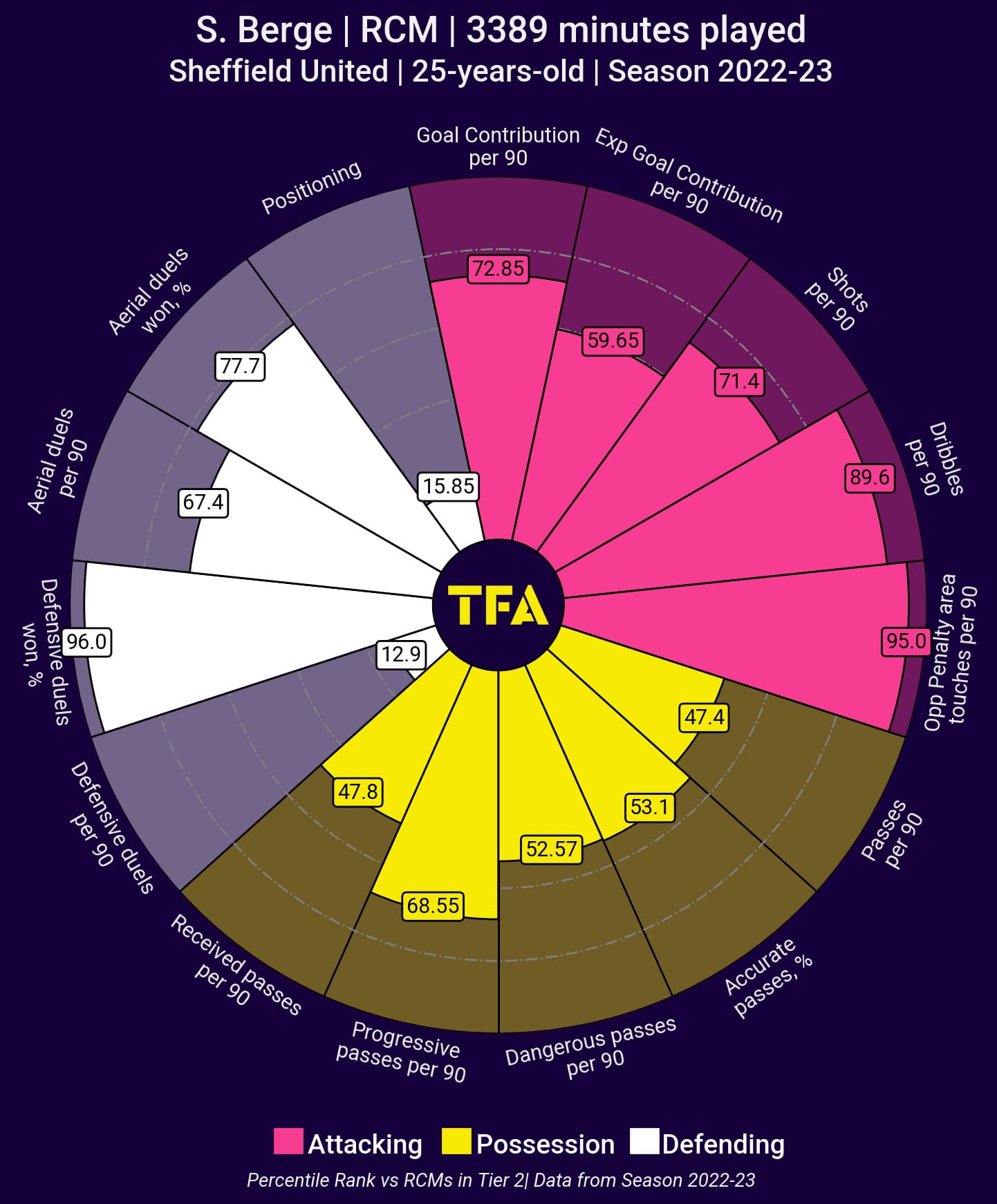
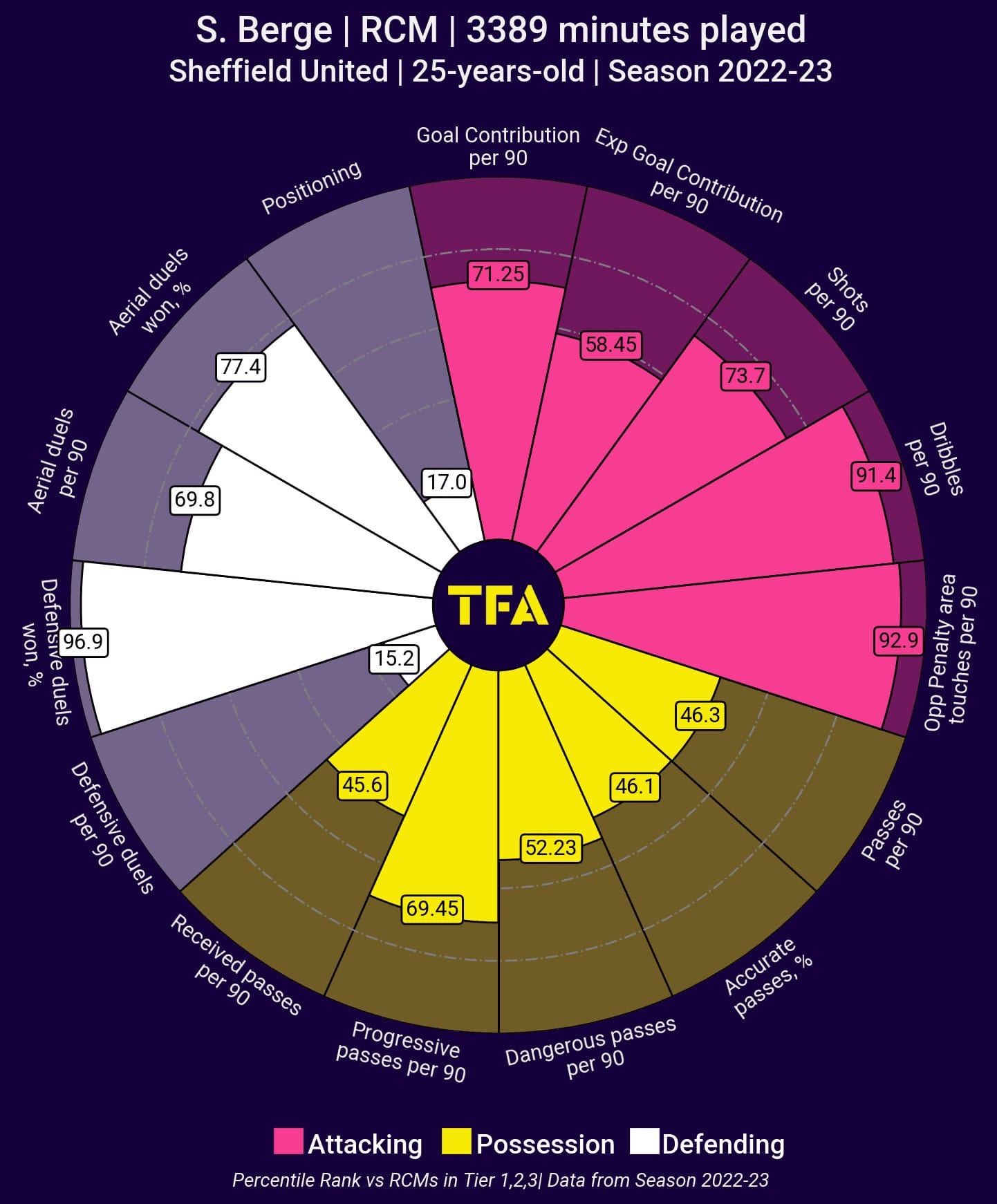
The pizza charts above allow us first to see how Sander Berge performed compared to right-sided central midfielders in Tier 2 leagues.
Additionally, in Pizza Chart 2, we can compare Berge to players in the same position across leagues in Tier 1, 2 and 3 to generate a more comprehensive idea of his game.
We can see from Pizza Chart 1 that Berge is someone who likes to carry the ball, as he ranks highly in terms of dribbles per 90.
Moreover, we can see that his goal contributions exceed his expected contributions, which indicates he can score low percentage chances or accurately play difficult passes to set up his teammates.
Berge is capable of playing progressive passes which is very beneficial when building an attack, especially as he is more of a box-to-box player than a playmaker.
We can see from Pizza Chart 2 that he fares well in this metric, making him an asset for Burnley as they look to retain their top-flight status.
Furthermore, the Norwegian midfielder plays an active role defensively.
While his rate of defensive duels per 90 may appear lower (possibly influenced by Sheffield United’s playing style and the positional instructions given to Berge), he boasts a strong success rate in the defensive duels he engages in.
This shows that he contributes significantly in the defensive phase of play.
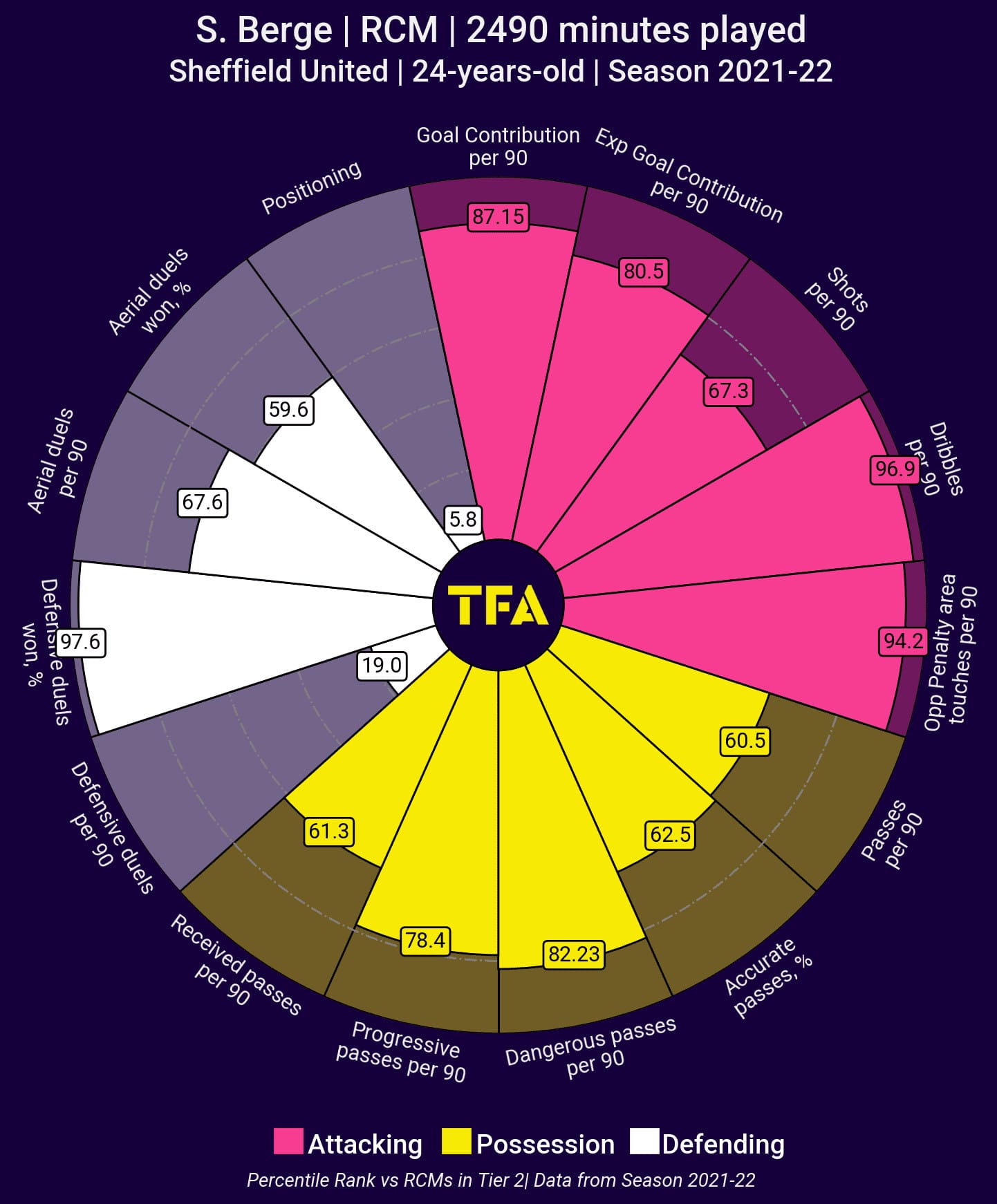
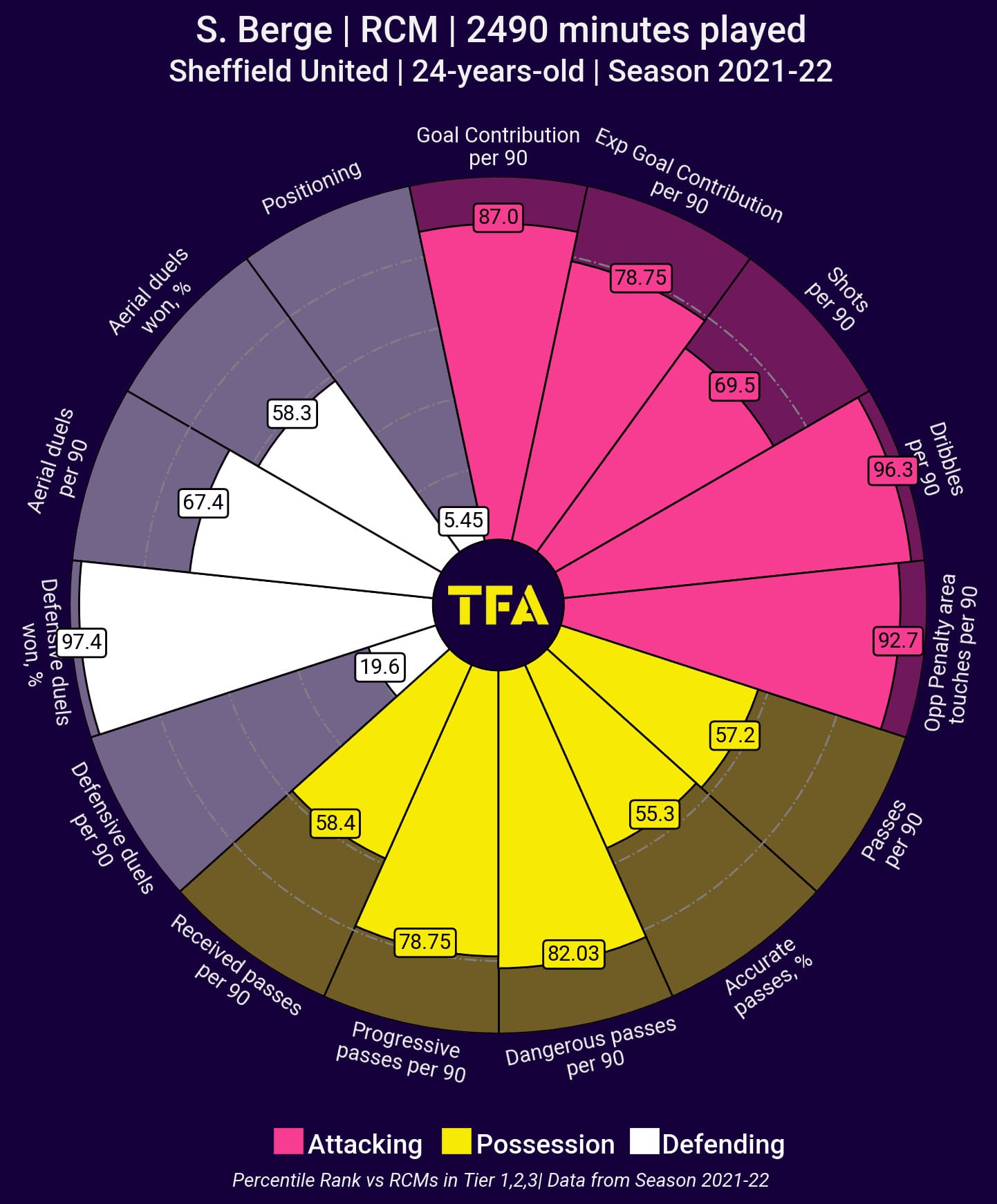
We know that Berge has been in demand for several seasons, this is primarily due to his consistency.
The pizza charts above give us an idea of how he performed in the 2021/22 season, where Sheffield United narrowly missed out on promotion.
From Pizza Chart 3, we can infer that Berge performed highly in terms of dribbles per 90 and touches in the opposition penalty area during the 2021/22 season.
Therefore, we can infer that his desire to progress the play and get forward is crucial to his game.
It is also apparent that he actually performed better in possession during this campaign.
Many factors will affect this, though, such as tactical changes to Sheffield United’s style of play or teams recognising Berge’s importance to Sheffield United’s progressive play and looking to limit his influence on the game.
sander berge playing style – Right place at the right time
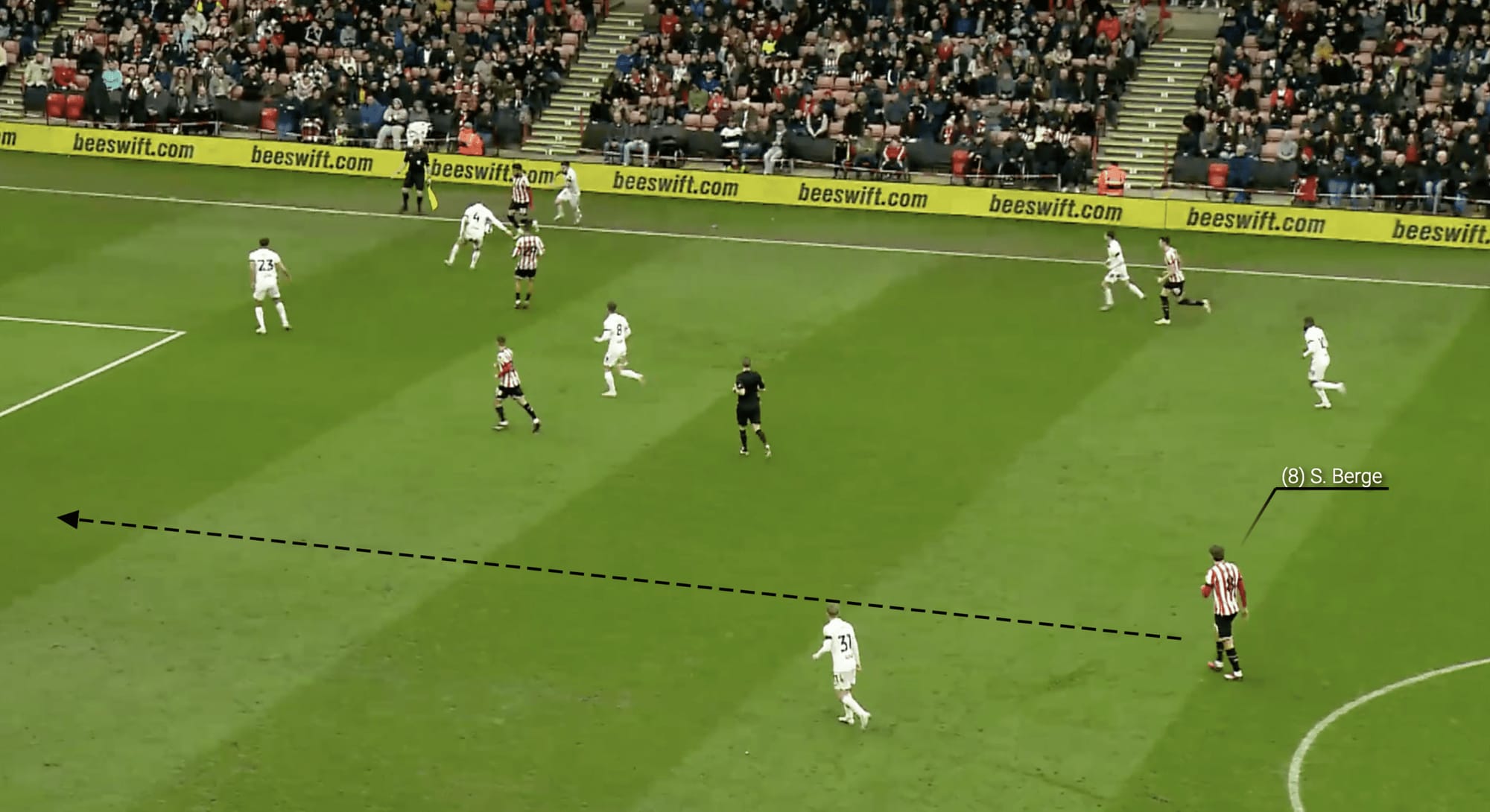
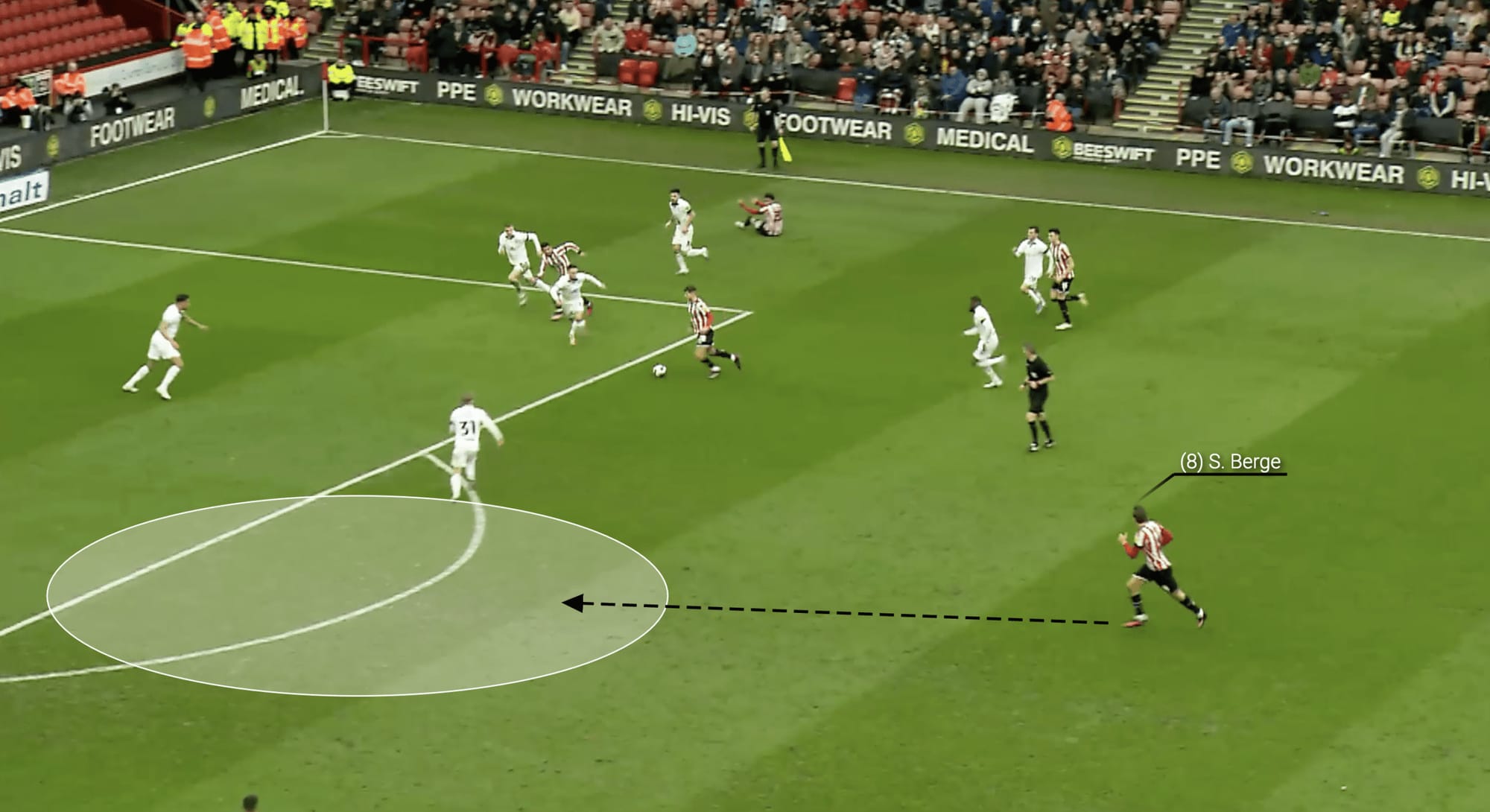
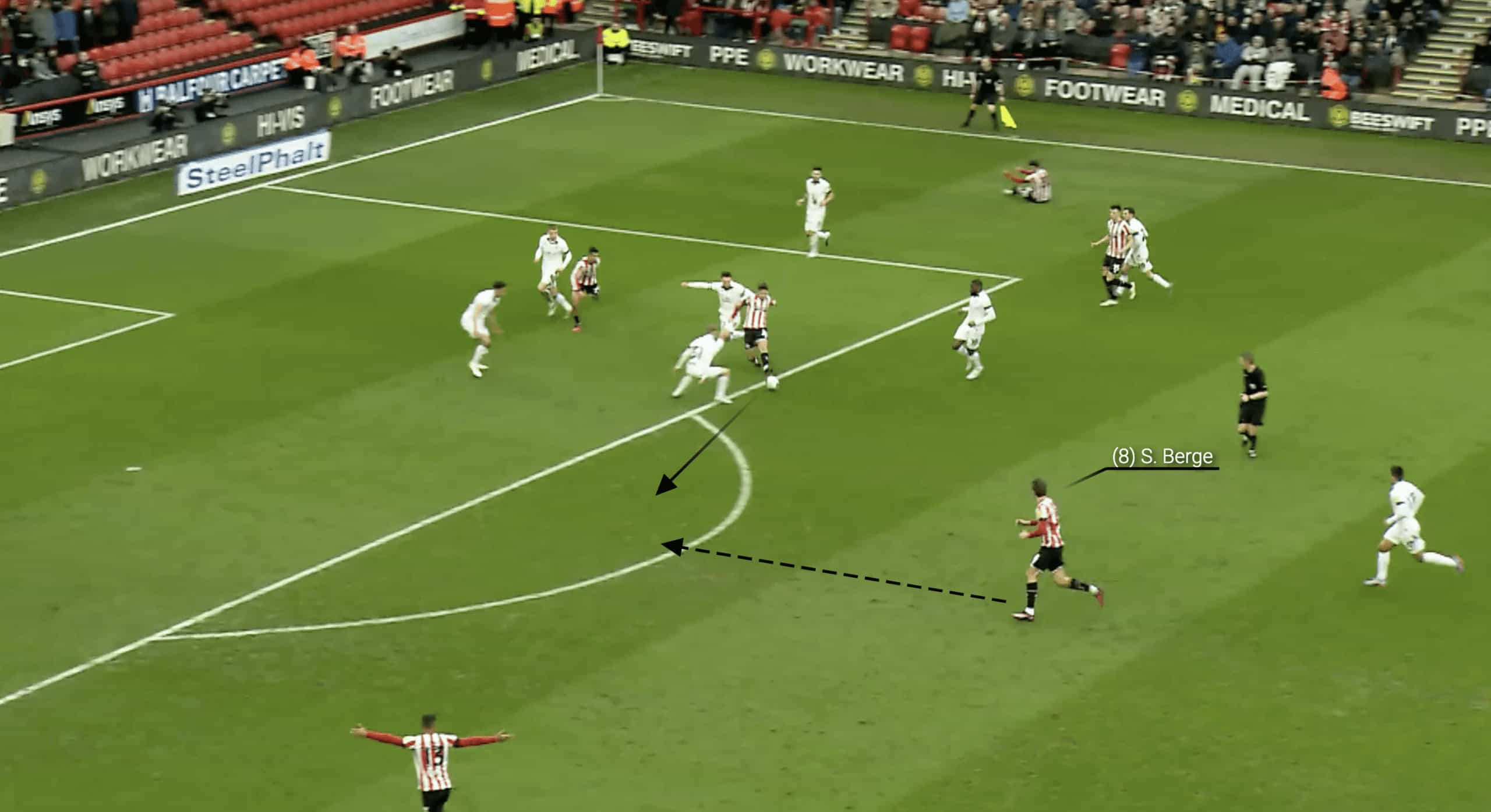
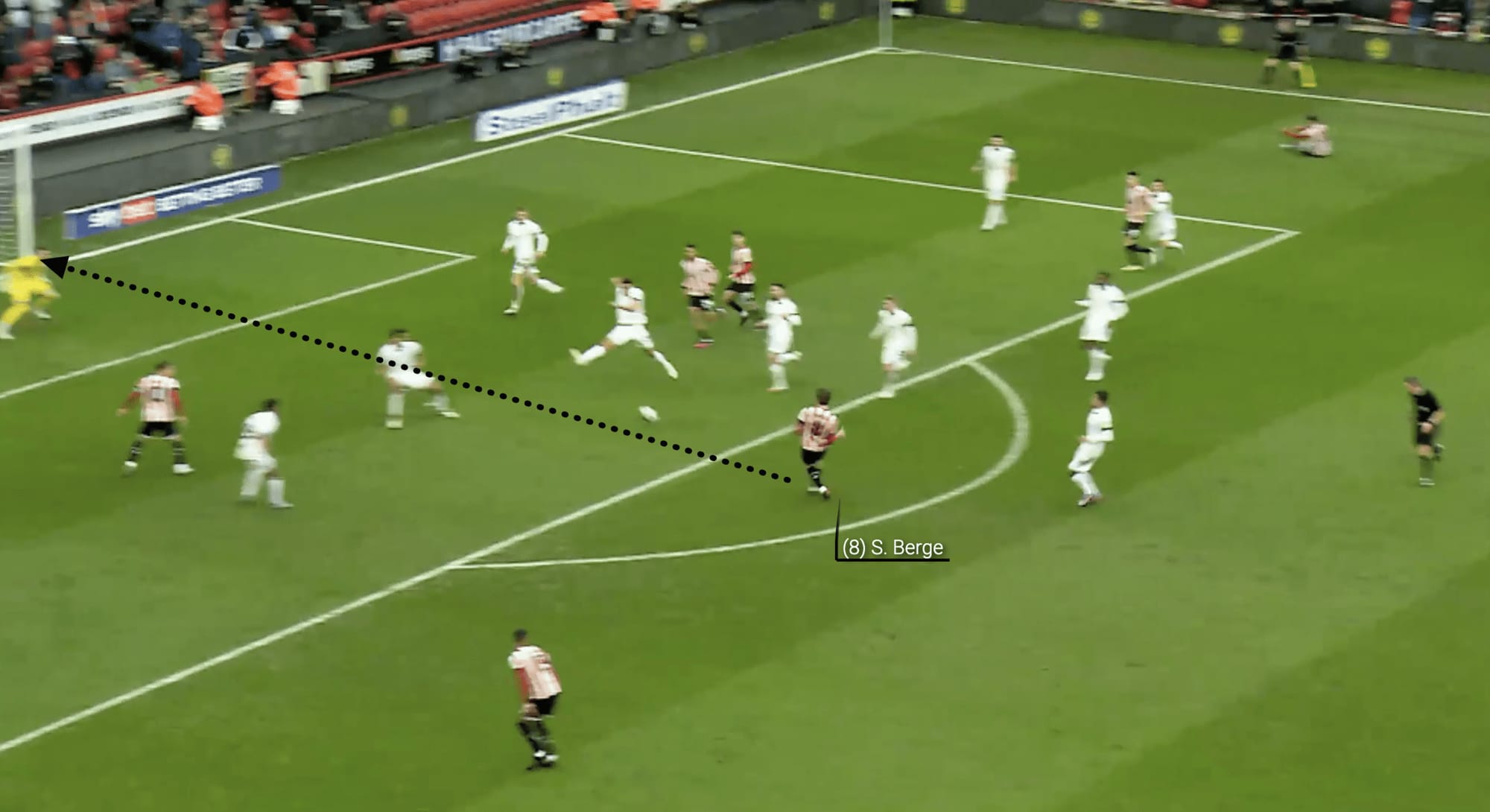
In the attacking phase, Sander Berge displays a beautiful ability to pop up in the right place at the right time.
The midfielder contributed six goals and three assists last season, and the images above display his excellent reading of the game.
Berge likes to make late runs to the edge of the area when possible, as he is very effective in and around zone 14.
This can prove to be an invaluable addition as it allows him to get shots on goal – Berge averaged 1.38 shots on target per 90 last season; plus, it means he is on hand to recycle possession and allows his team to maintain the attacking pressure.
In the scenario depicted above, Berge can make one of his late runs to the edge of the area; of course, we have to acknowledge some poor defending on behalf of the opposition as they fail to track his run.
However, the ball must still hit the back of the net, and when his teammate plays a pass into his path, United’s number 8 is able to strike a first-time shot beyond the goalkeeper.
Sander Berge Heatmap
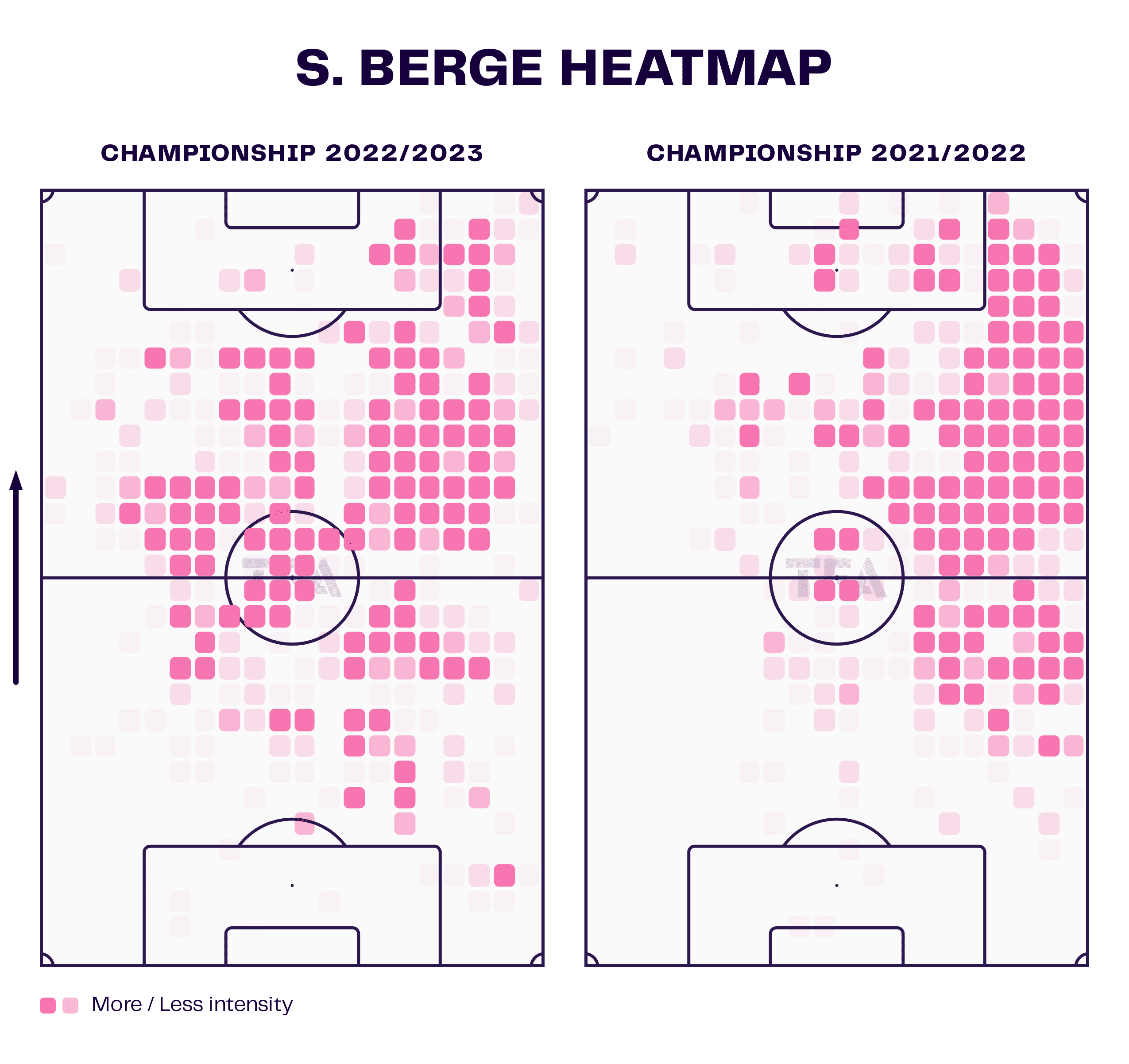
The heatmaps above show where Berge was most active on the pitch throughout the 2022/23 and 2021/22 campaigns.
He primarily operates in the central right midfield area and the right half-space.
Although, during last season, he also was very active in more central locations and occasionally on the left side of the main midfield area.
Sander Berge Progressive play
As we have established, Berge loves to involve himself in the attacking phase and really looks to play progressive passes or make progressive runs into the attacking third.
The data visual below shows that he performed above average in both metrics last season, averaging 5.47 progressive passes per 90 and 2.23 progressive runs per 90.
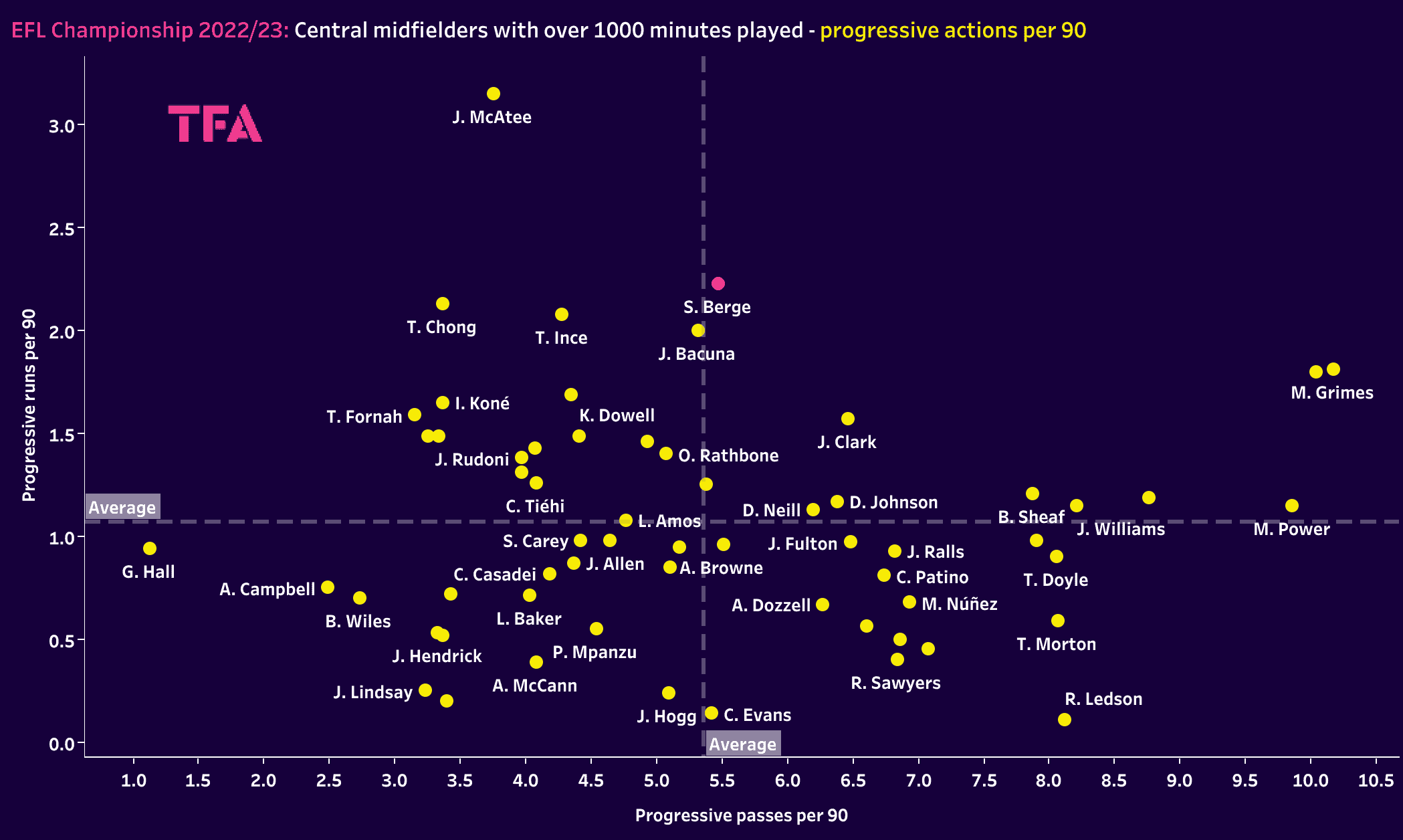
Berge’s progressive contributions are instrumental in the attacking phase, as when the central midfielder consistently executes accurate progressive passes, it enables his team to transition swiftly from defence to attack.
By bypassing crowded areas and exploiting spaces, these progressive passes create opportunities for his teammates to receive the ball in advantageous positions, leading to more effective attacking plays and potential goalscoring chances.
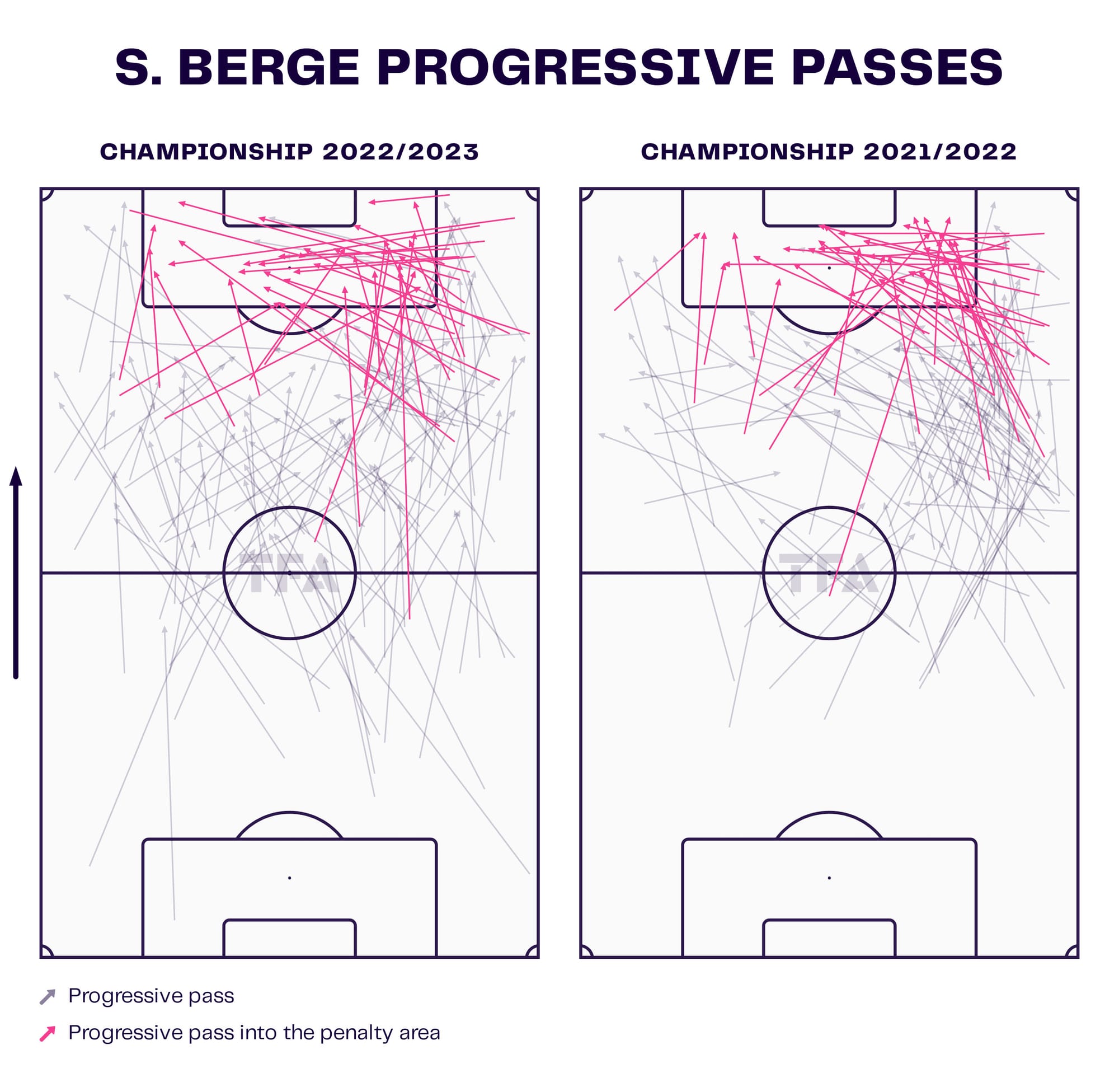
From the data visual above, we can see where Berge’s progressive passes occurred on the pitch over the last two seasons.
As expected, the majority played into the penalty area are from the right half-space.
Interestingly, looking at the data viz for the 2022/23 season, it is clear that more of Berge’s progressive passes originate deeper in the Sheffield United half.
This could indicate that he was more involved in the transition from defence to attack as the Blades sought to make good use of his passing abilities.
Clarets manager Vincent Kompany has stated that Berge’s progressive play is one of the reasons that he wanted to bring the Norwegian to Turf Moor, stating:
“He’s an intelligent footballer with a great eye for a pass and the ability to run with the ball.”
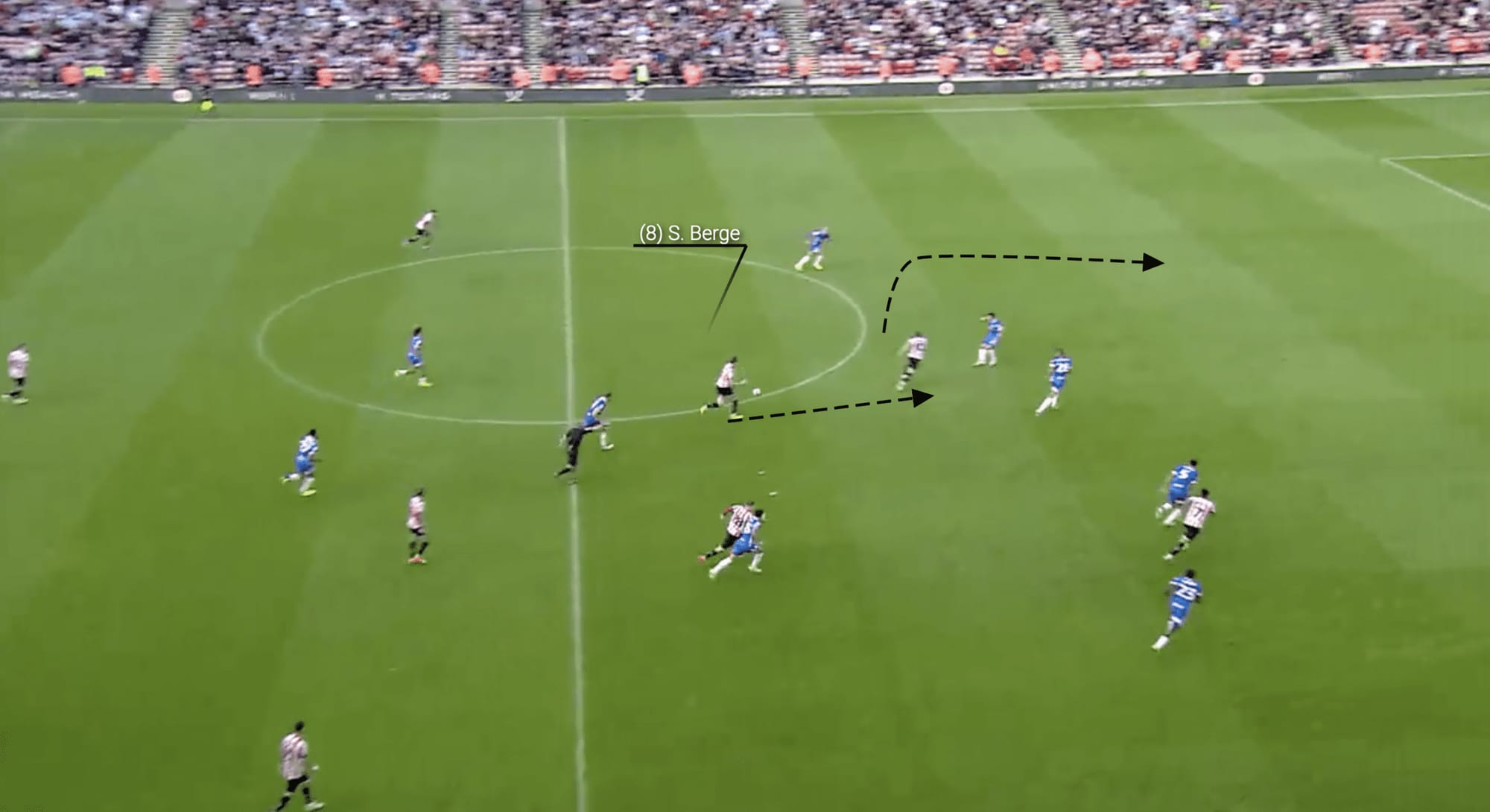
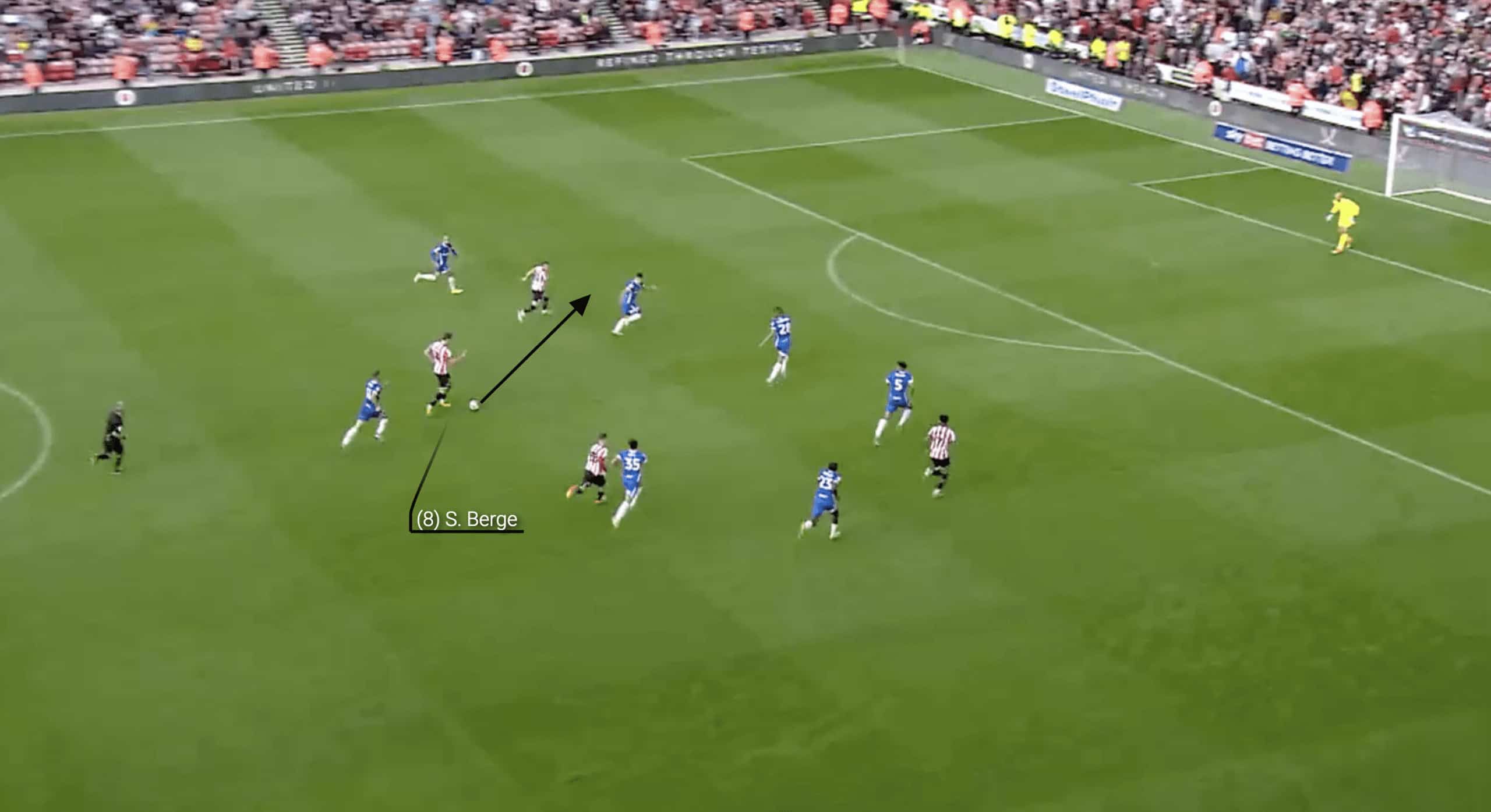
We can see some in-game examples of the midfielder’s progressive play; here, for example, he picks up the ball, carries it forward and then plays an inch-perfect pass into the path of Billy Sharp.
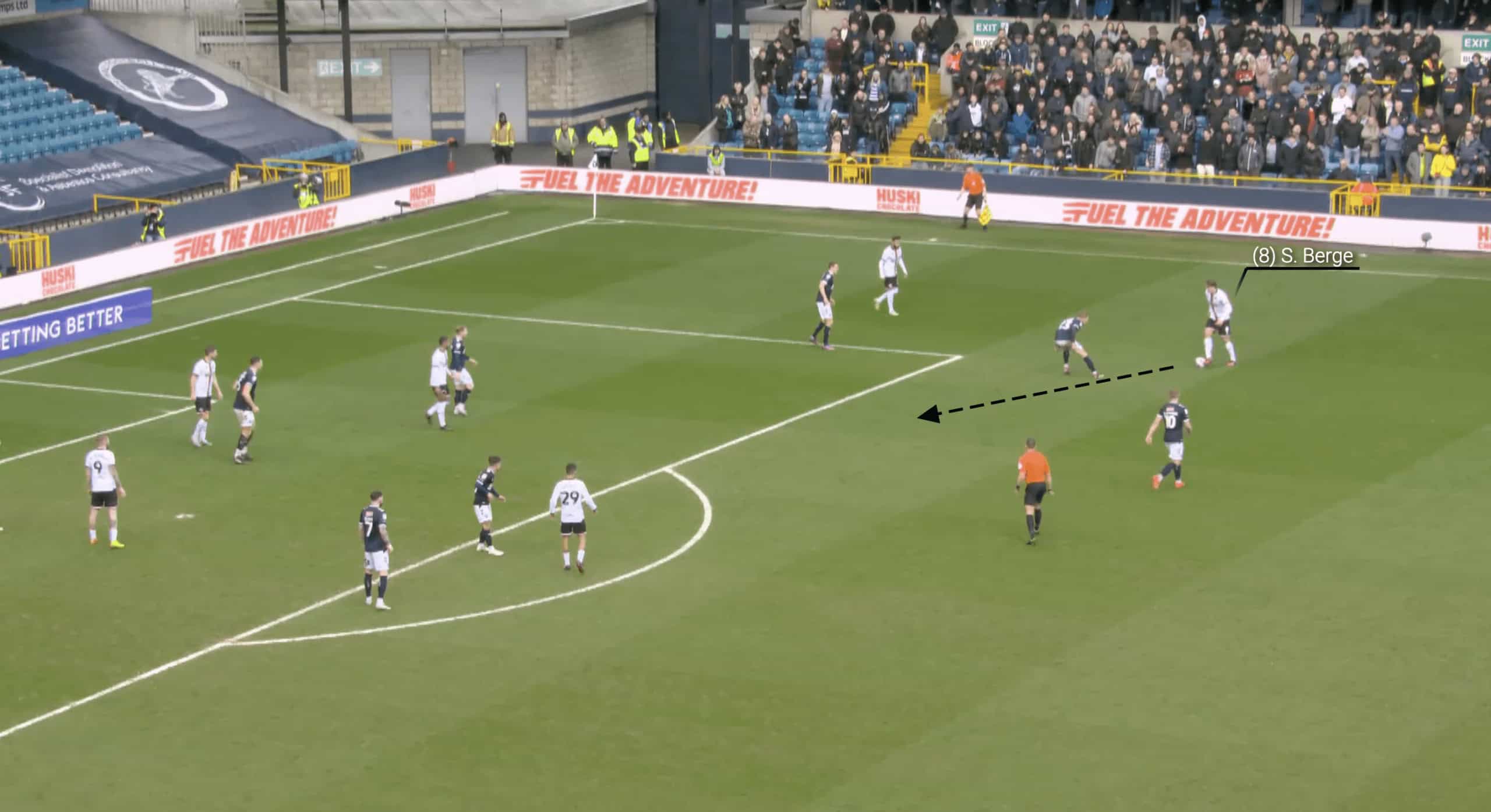
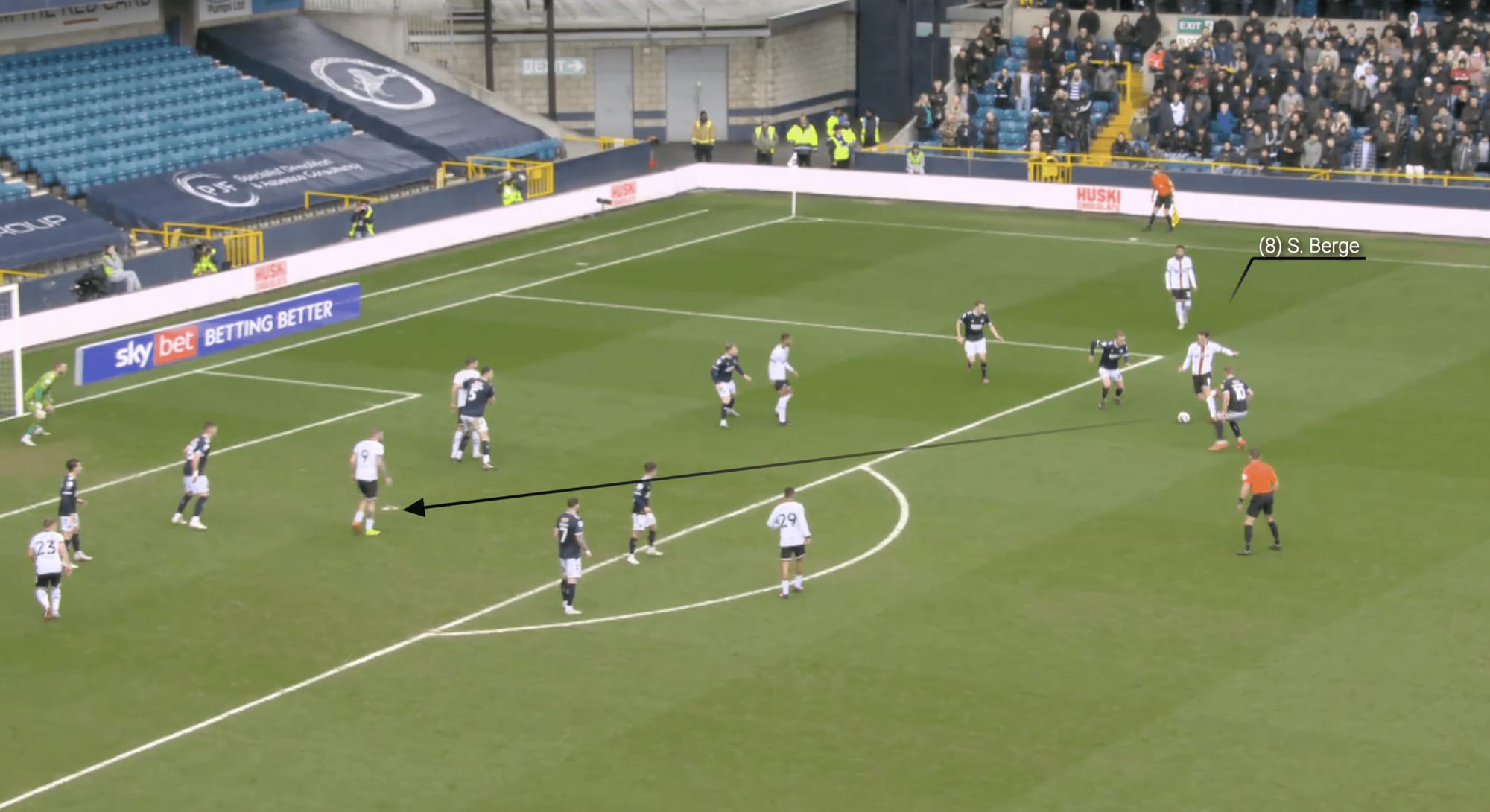
In this scenario, the new Burnley signing demonstrates his vision and ability to play the unexpected pass as he firstly is able to evade the defender and carry the ball forward.
He then uses the outside of his boot to play a pass directly to Oli McBurnie, which catches the defenders off guard and allows the United striker to get a shot on target.
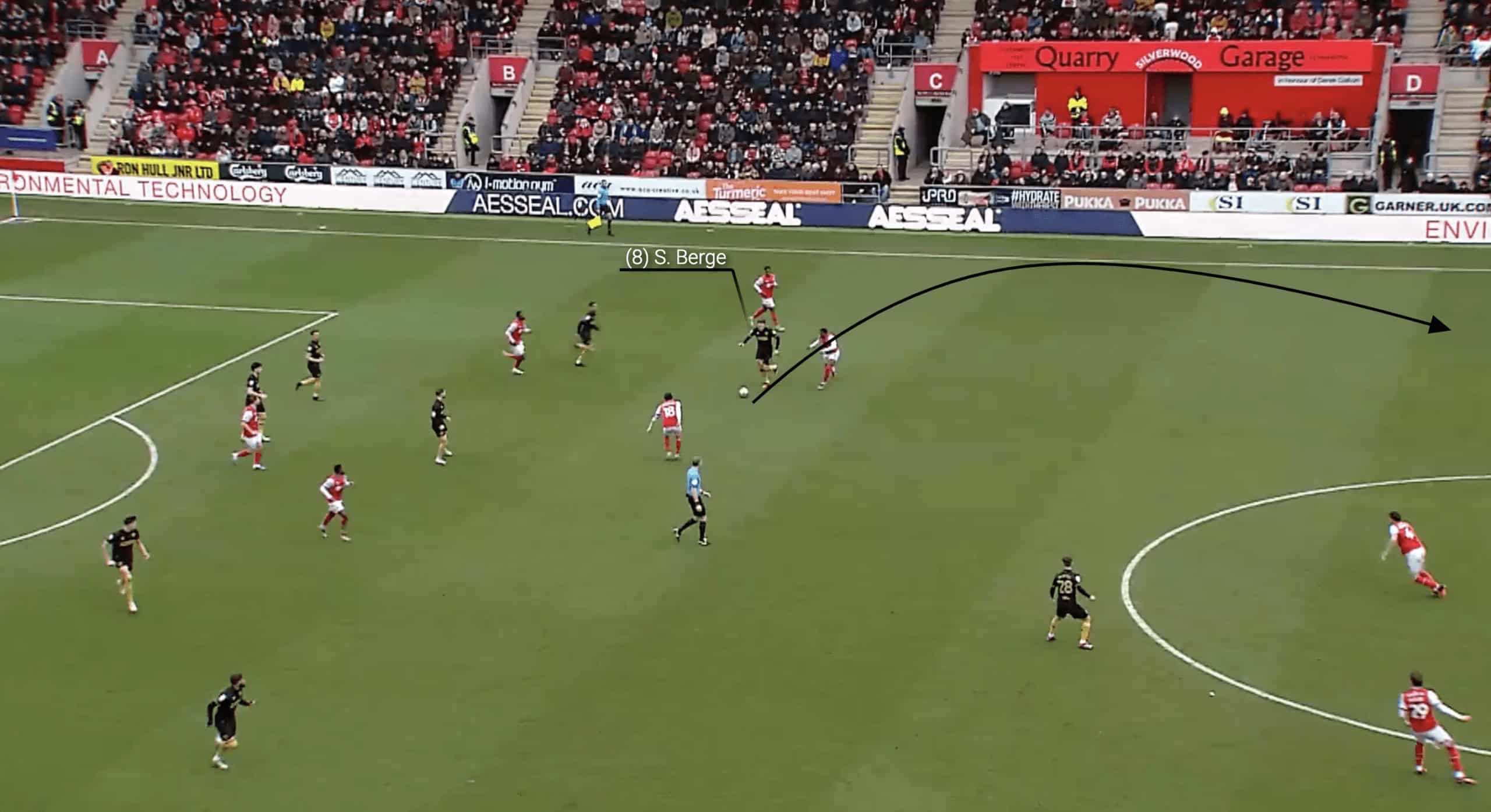
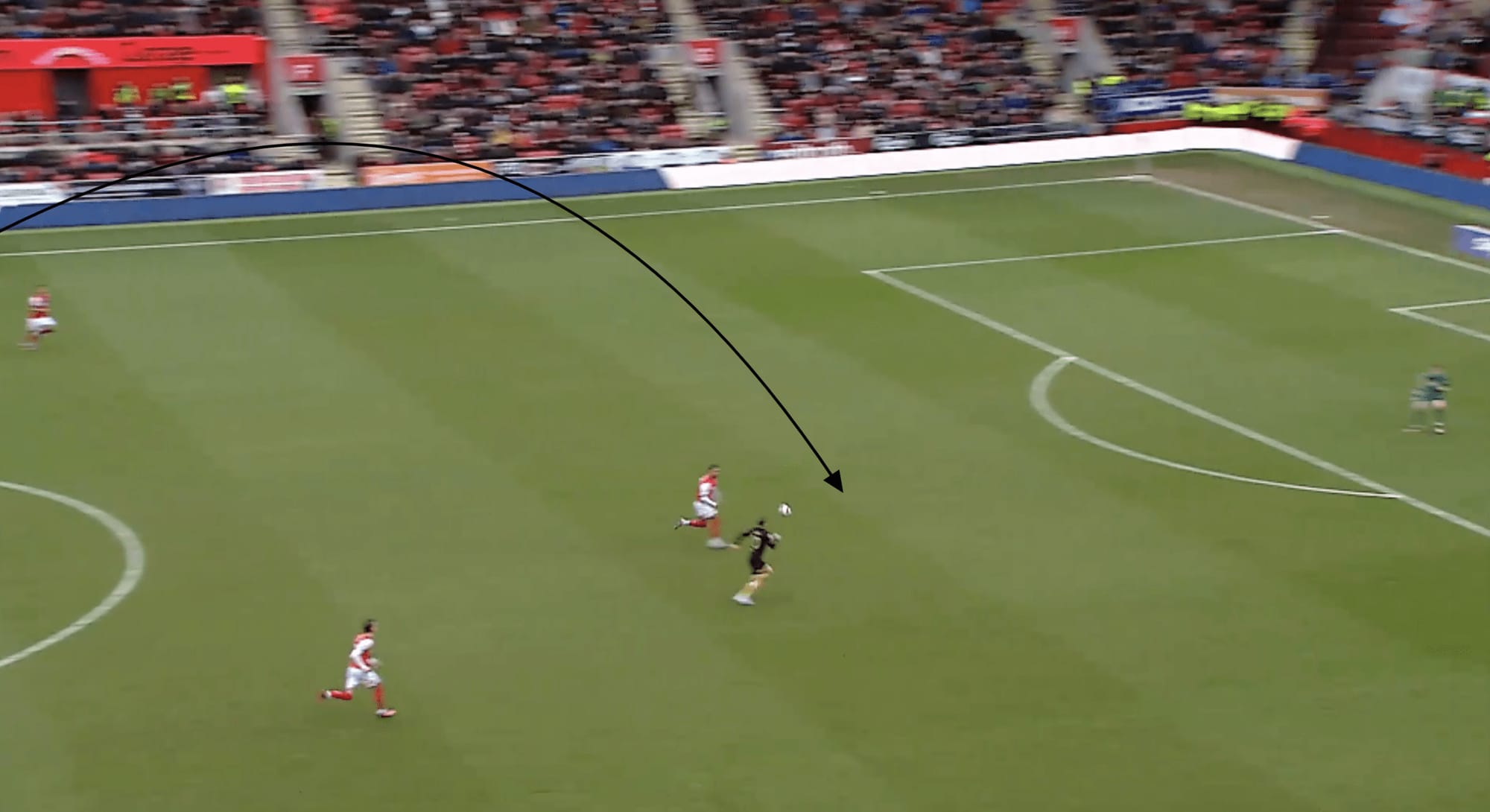
It is not only short passes that Sander Berge can utilise; he has an excellent passing range which is frequently on show throughout the game.
He uses his long passing to ensure the team transitions from defence to attack rapidly.
Not only is Berge able to execute such passes regularly, but he is also very accurate with it, averaging a 60.5% accuracy rating on his long passes last season.
Berge excels at playing the types of passes which are calculated risks that often catch opponents off guard.
When he threads a ball through tight spaces or attempts a long-range pass, he is able to disrupt the opponent’s defensive shape and force them to readjust quickly.
This is how he creates sudden openings in the defence and catches defenders out of position, leading to goalscoring opportunities that might not have been possible through more conventional play.
Furthermore, Berge’s on-the-ball abilities showcase his high level of in-game intelligence.
He is able to exploit the weaknesses in the opposition’s defensive structure.
He is a midfielder who consistently makes intelligent passes, identifies gaps and vulnerabilities in the defence, and exploits them by delivering accurate and well-timed balls to teammates in advantageous positions.
This allows his team to capitalise on moments when the opposition is most vulnerable, leading to high-quality scoring chances.
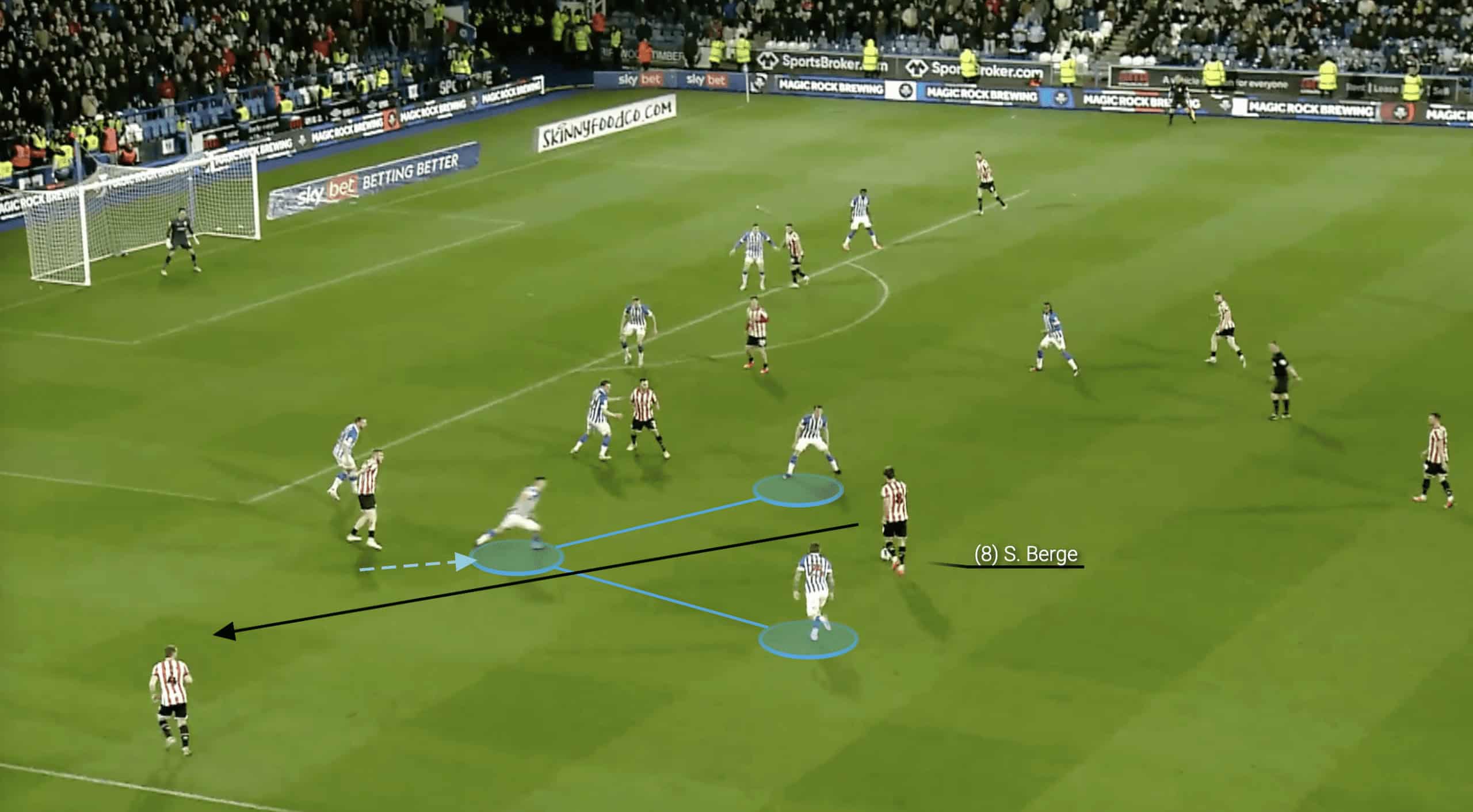
Defenders seek to close Sander Berge soon as possible.
As we can see above, two opposition players are close to him, with a third moving to press him.
Whilst the opposition seeks to encourage him to limit his influence on the game, the highly skilled midfielder is able to bypass this as he never holds onto the ball for too long.
He has a great awareness of his surroundings and displays a great understanding of when to release a pass to a teammate.
When the third defender makes a move towards him, Berge releases a disguised pass out to Jon Fleck, who was in plenty of space out wide.
This meant that Fleck had time and space to execute a ball into the box as the opposition attempted to create a numerical overload to prevent Sander Berge from progressing the play in the more central area; it generated space out wide for United to exploit.
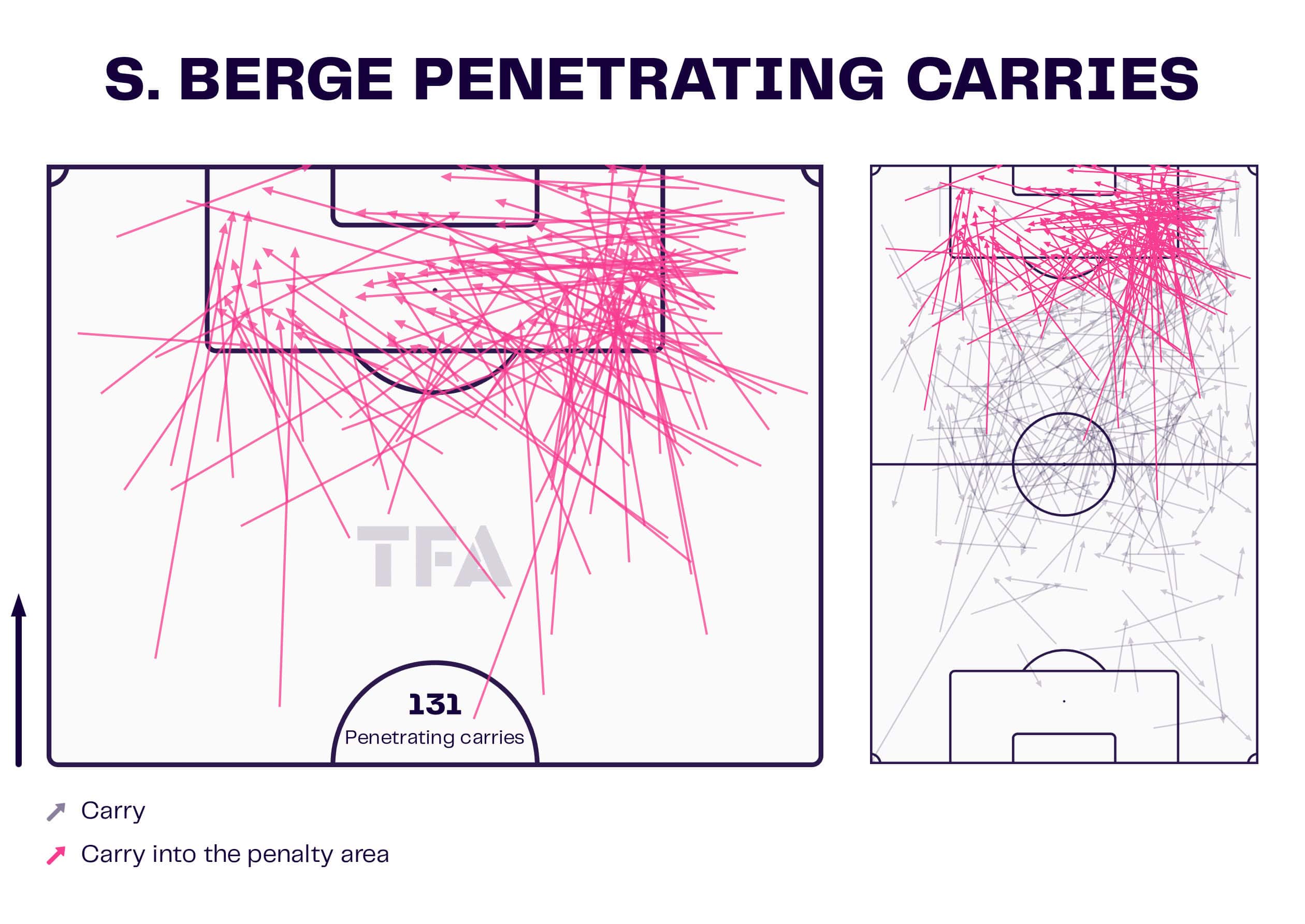
As Kompany states, Burnley was also keen to secure Berge’s signature because of his ability to carry the ball.
The data visual above shows that he executed 131 carries into the penalty area during the 2022/23 campaign.
This was a valuable element to the Sheffield United attack.
Berge’s penchant for advancing into the opposition’s penalty area forces the defensive line to react and adapt; as he dribbles forward, defenders need to step out and close him down, creating space in behind.
Consequently, this puts direct pressure on the opponent’s defensive organisation; therefore, as he carries the ball forward, the opposition must decide whether to engage and challenge the ball carrier or drop back to protect the penalty area.
Moreover, as Berge is a player who ventures into the opposition penalty area, this provides an extra target for crosses and deliveries from wide areas.
When the team is in an attacking phase, the Norwegian midfielder’s presence in the box can add an element of unpredictability to the opponent’s defensive marking.
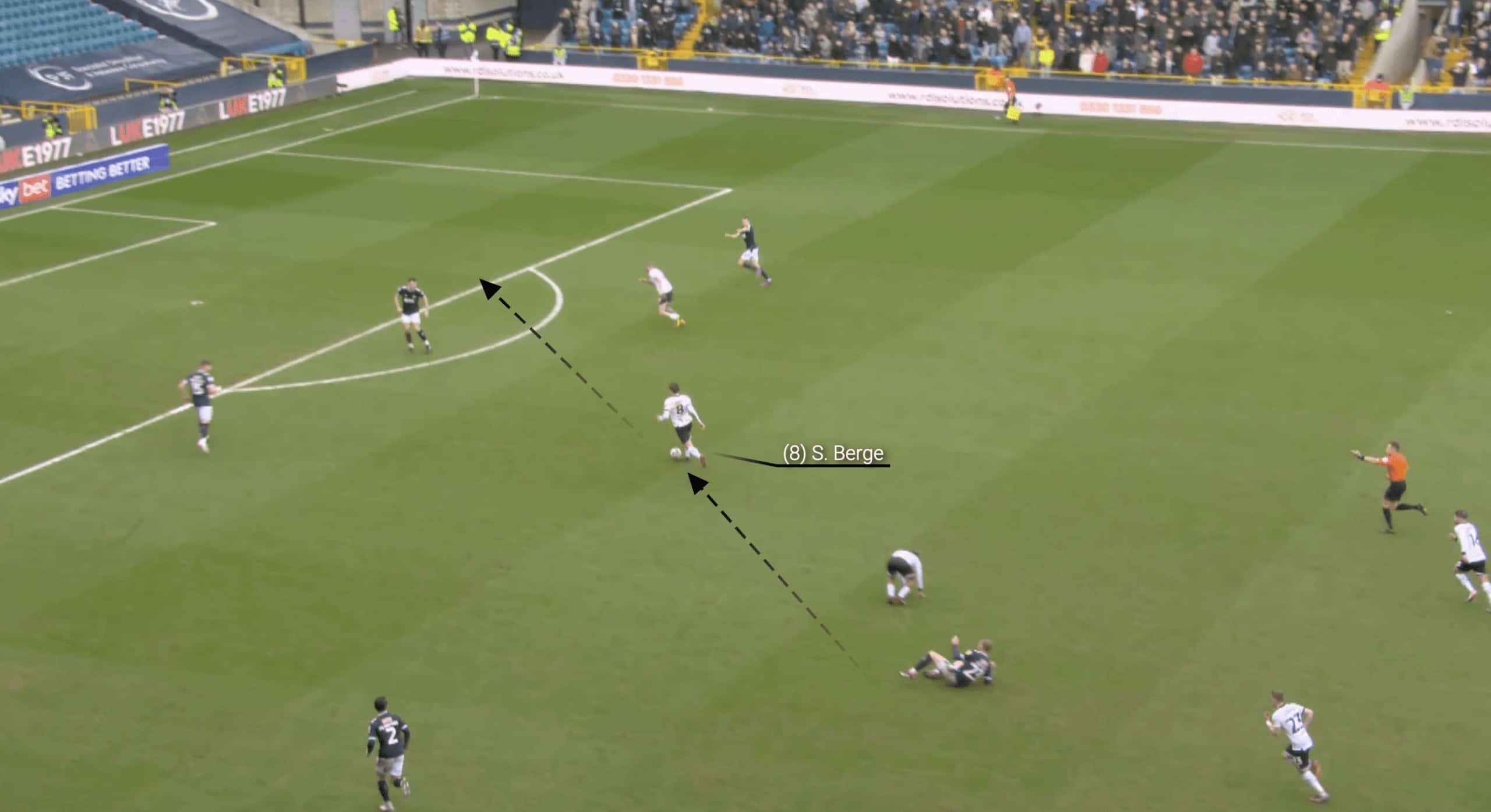
This image demonstrates Berge carrying the ball into the opposition area as Sheffield United quickly transitions from defence to attack.
His direct running at the defence is a fantastic asset as the team looks to progress up the pitch.
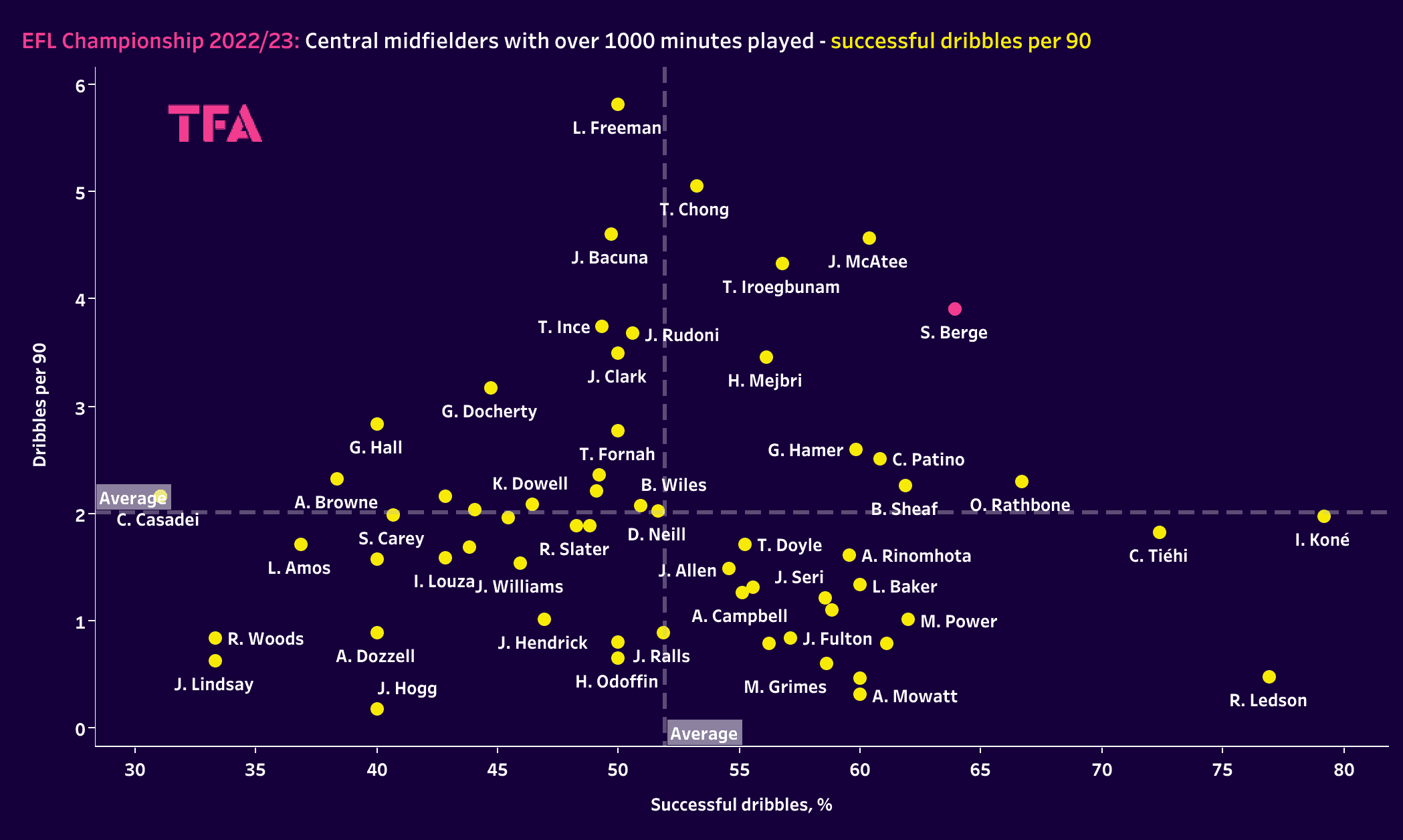
The data visual above shows us just how efficient Berge is when dribbling the ball compared to his EFL Championship counterparts.
With an average of 3.90 dribbles per 90 and a 63.95% success rate, he ranked well above average in these metrics.
Sander Berge Defensive positioning
It is not just in the attacking phase where Sander Berge is effective.
He more than plays his part in the transitions from attack to defence and the defensive phase.
However, Berge averaged just 3.03 interceptions per 90 during the 22/23 season; whilst this ideally could be a little higher, he has excellent awareness and defensive positioning, as we will discuss.
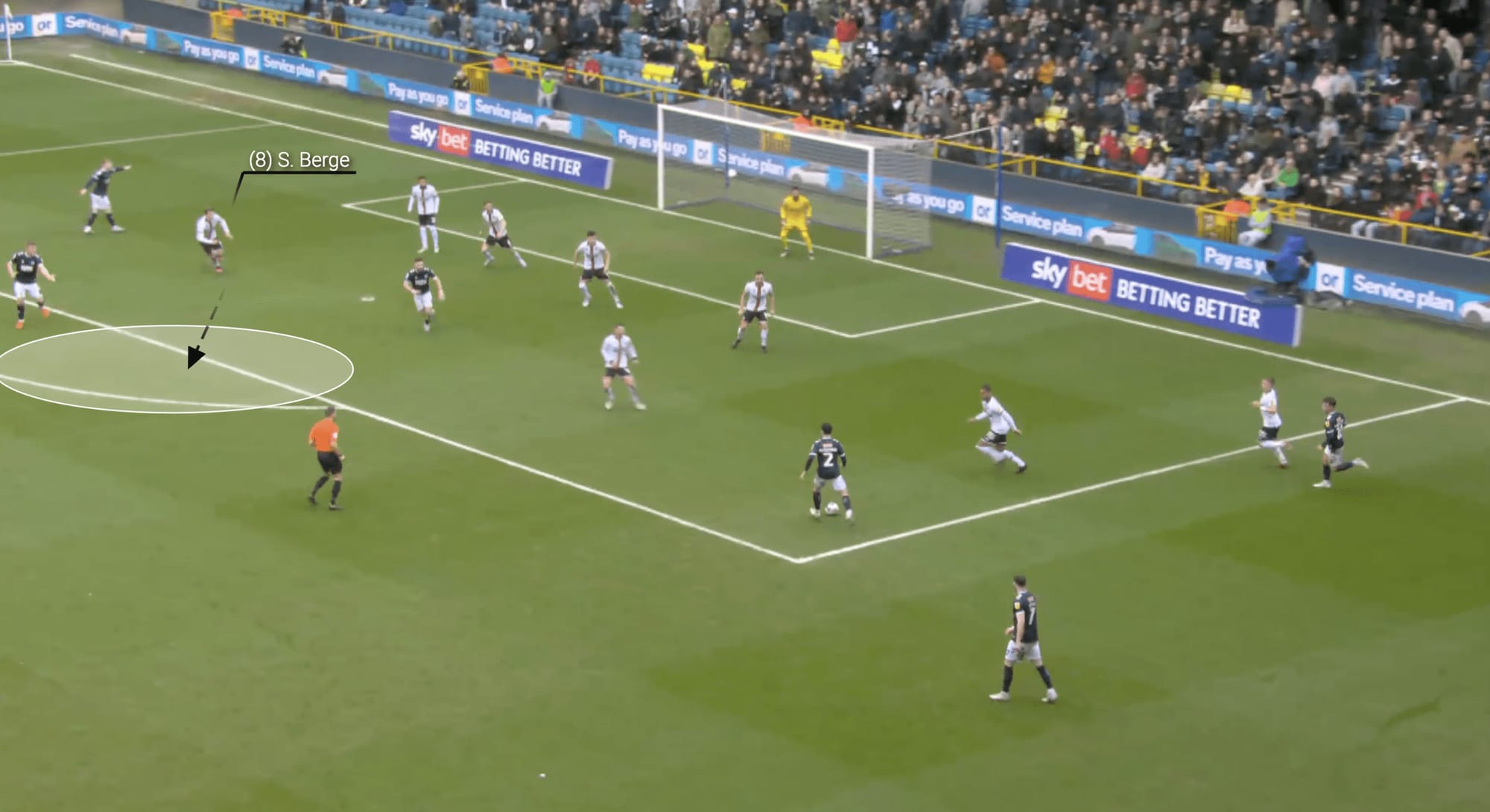
In this instance, Berge displays his defensive awareness as he quickly reads the play.
Understanding that a pass will likely find its way to the player on the edge of the area, he quickly alters his body orientation and hastily moves to make the interception.
Having a midfielder with excellent defensive awareness is beneficial to a team as he is adept at reading the game and anticipating opponents’ movements.
This enables Berge to intercept passes, win back possession, and disrupt the opponent’s passing lanes, as seen above.
He can regain the ball and launch the transition to the attacking phase by consistently making well-timed tackles and interceptions.
This could bolster the team’s ability to initiate counter-pressing and win back possession high up the field, which Vincent Kompany may utilise with Burnley.
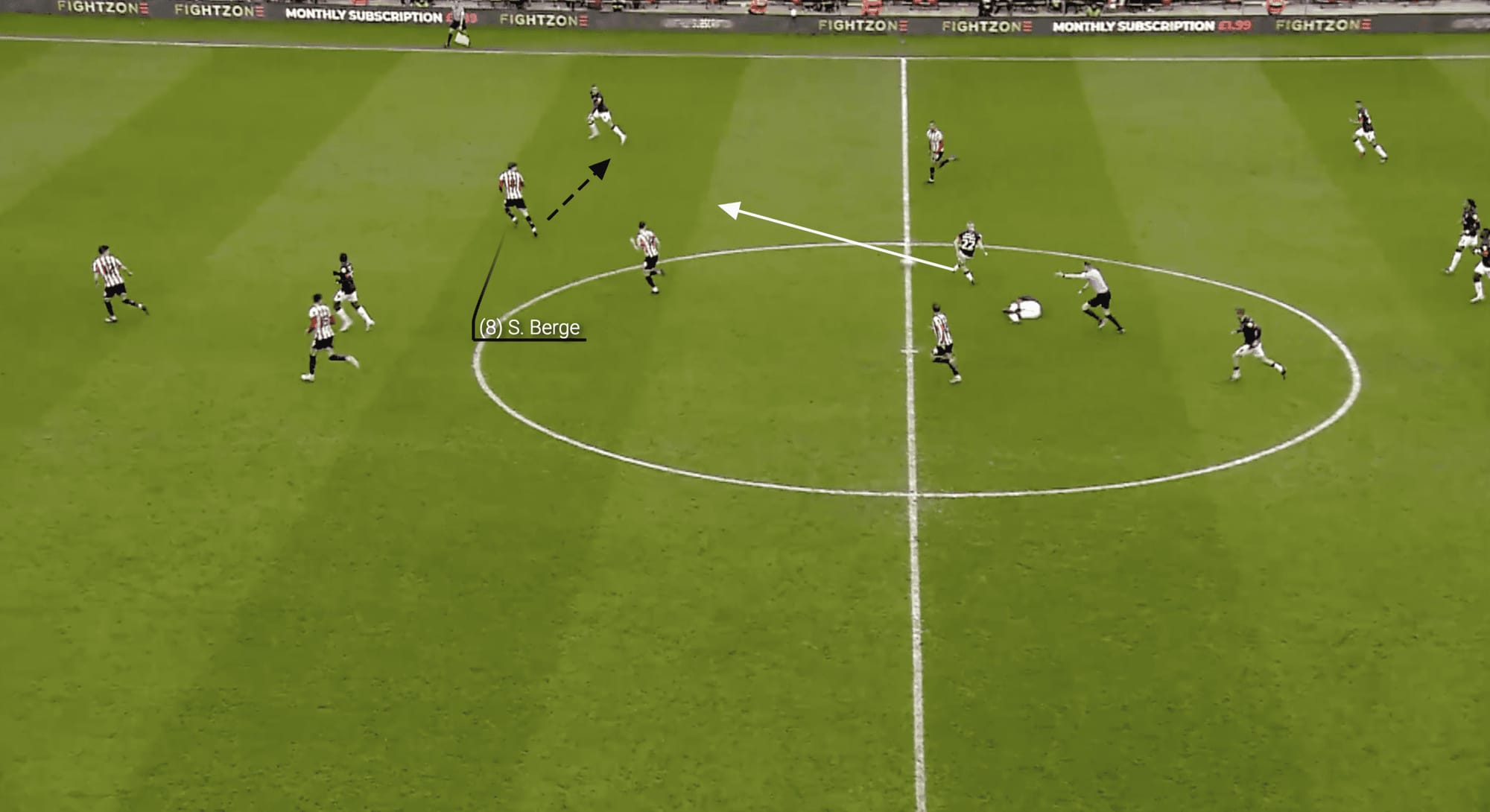
During the transition from attack to defence, Berge constantly scans, assessing which opposition player poses the biggest threat.
Here we can see him tracking back and reading the play well, which allows him to step in and make a vital interception which halts the opposition’s counterattack.
Since Berge is someone who actively scans the play, this means that he is able to gather real-time information about the positioning of both his teammates and opponents.
This heightened awareness allows him to make informed decisions quickly and accurately, whether identifying the player to track or knowing when to step in to intercept.
By constantly scanning the play, he can read the unfolding situation effectively and adjust his positioning and movement accordingly.
Additionally, as a box-to-box midfielder, Berge is willing to track back swiftly during the transition phase, which is crucial for maintaining defensive solidity.
When the team loses possession and transitions from attack to defence, he is able to fill defensive gaps and prevent opponents from exploiting spaces left open by the attacking movement.
This reduces the risk of the opponent successfully being able to counterattack or quickly transitioning into dangerous attacking positions, thereby bolstering the team’s defensive resilience.
Where will Sander Berge fit in at Burnley?
In this tactical analysis, we have analysed the reasons why Vincent Kompany and Burnley targeted Sander Berge; now, let’s look at where he will fit into the team tactically.

The graphic above shows that Kompany mostly favoured a 4-2-3-1 or a 4-3-3 formation last season.
Should he opt for the latter, we will most likely see Berge utilised as a right-sided central midfielder, similar to his time at Sheffield United.
As we have shown in this scout report, Sander Berge is a player who loves to get forward, so he will thrive in this role, especially if there is a defensive midfielder there to provide additional defensive cover.
Sander Berge can operate as a defensive midfielder should Kompany prefer, as this is where he primarily played during his time at Genk.
However, the most significant development in his game has been his attacking output, so by playing Berge as a defensive midfielder, Kompany would be limiting a valuable attacking asset.
The 25-year-old will perform best if given permission to carry the ball upfield and can use his dribbling skills to carve out attacking opportunities.
He will undoubtedly bring his work ethic, and his defensive contributions will be beneficial as Burnley will be aiming to stay in the Premier League.
Burnley’s new man endured a tough debut against Manchester City, struggling to have any effect in the middle of the park.
Whilst this isn’t the best way to start his Burnley career, it’s important to remember they were playing the Premier League champions, and he had only signed for the club a couple of days prior.
Gustavo Hamer to Sheffield United
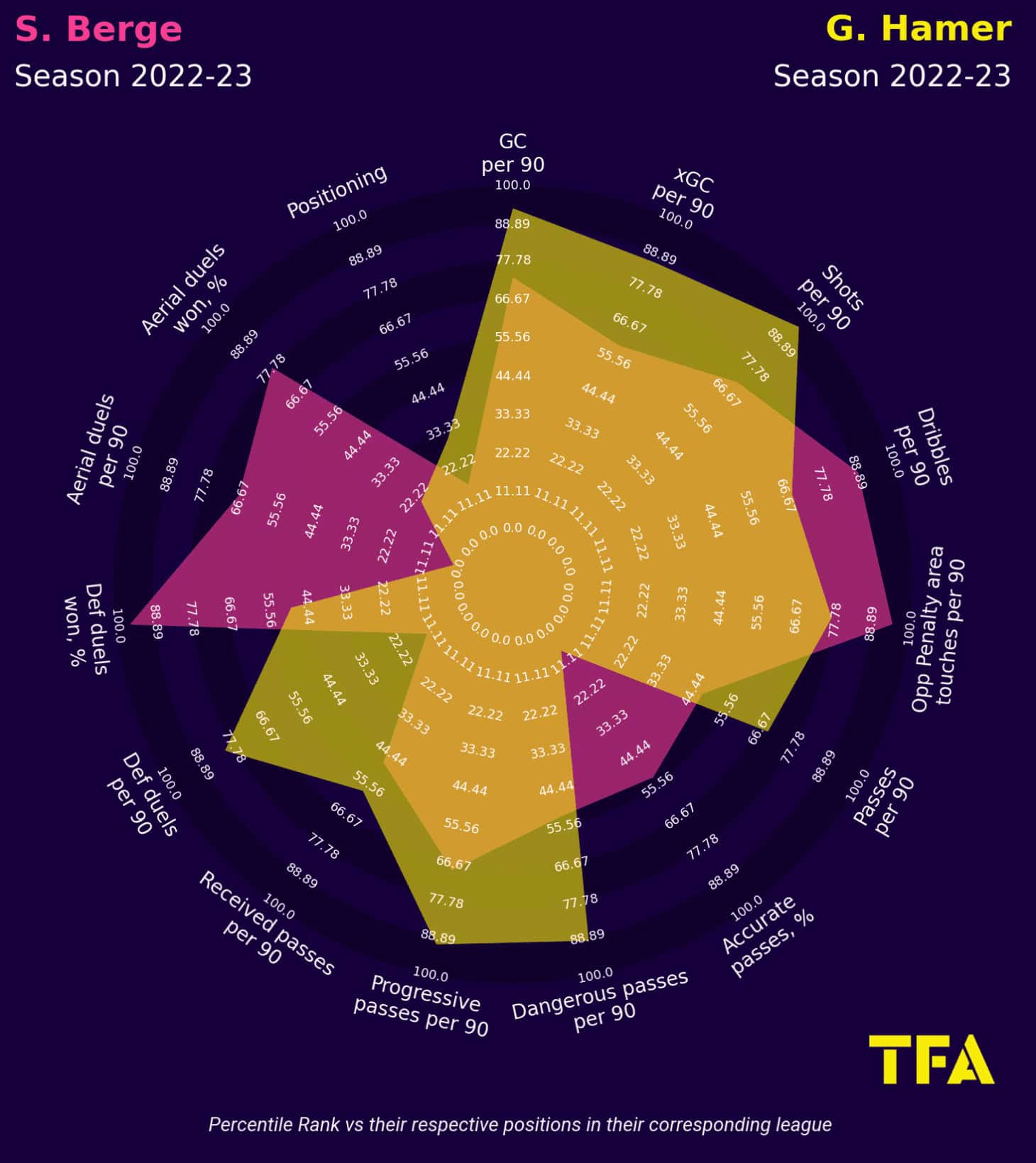
So, where does Sander Berge’s departure leave Sheffield United?
Well, some intelligent recruitment means that Blades may have found themselves an excellent replacement as they have secured the signature of Coventry’s Gustavo Hamer.
Coupled with the addition of Vinícius Souza, United’s midfield could be shaping up to be a fascinating prospect.
From the radar chart, we can compare Berge and Hamer.
Regarding goal contributions, we know that Hamer had a much better output.
He also played a higher number of dangerous and progressive passes per 90 than the new Burnley signing.
The midfielder, who narrowly missed out on promotion with Coventry, losing to Luton Town in the play-off final, enjoyed a stellar campaign last season; he finished the season with 11 goals from an xG of 7.22 and 10 assists from an xA of 7.64 to his name.
Hamer also took more than double the number of shots compared to Berge, which could be very useful as Sheffield United have lost their biggest goalscoring threat due to Iliman Ndiaye’s departure.
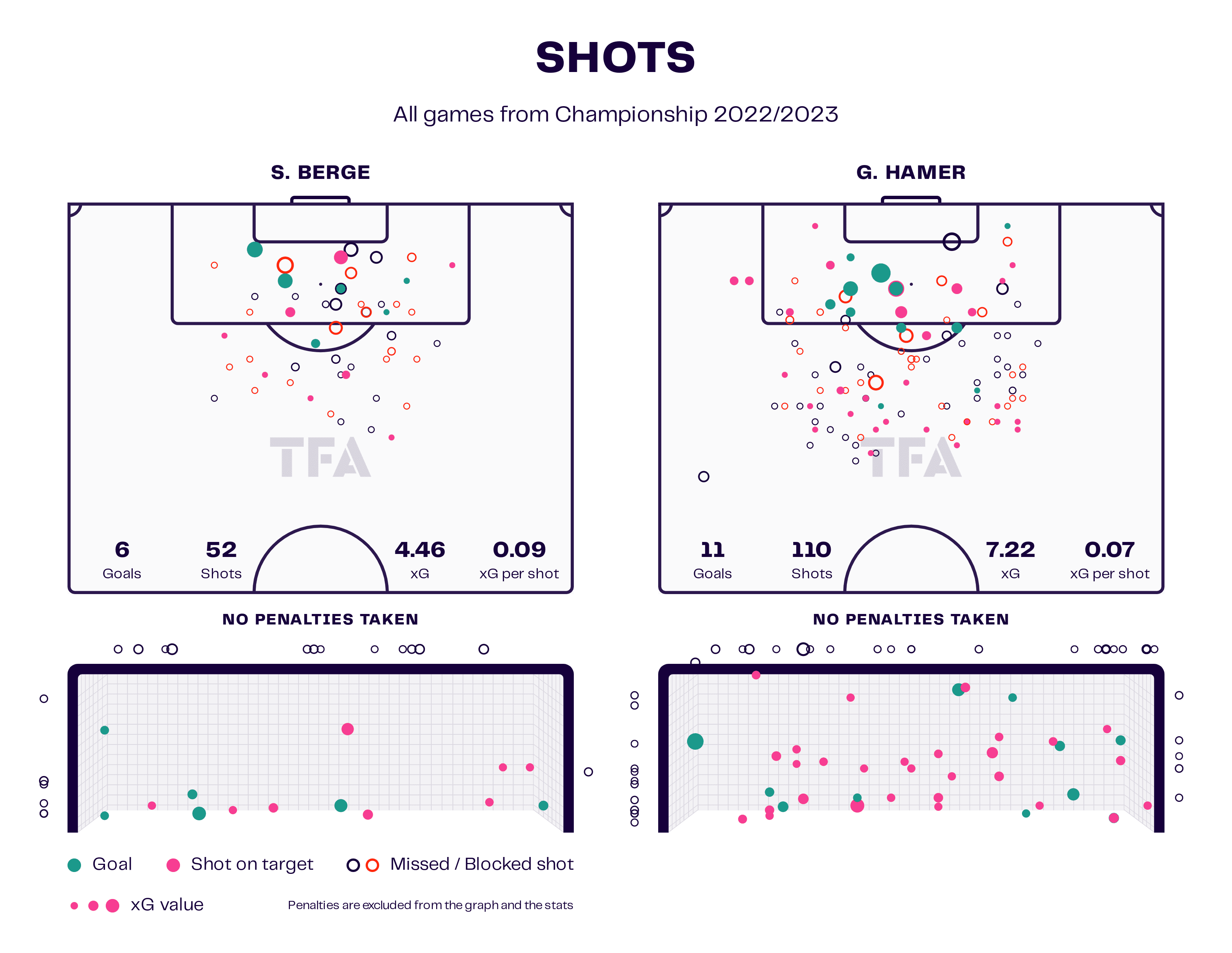
Hamer averaged 10.17 progressive passes per 90, significantly higher than Berge’s 5.47.
The data visual(s) below shows how vital he was to Coventry’s attacking play last season.
Everything went through him; the Brazil-born Dutchman averaged 10.02 passes into the final third with an accuracy rating of 63.9% and 3.11 passes into the penalty area with an accuracy rating of 45.7%.
By comparison, Berge averaged 4.67 passes to the final third, with an 83% accuracy rating, and 2.55 passes into the penalty area with a 62.5% accuracy rating.
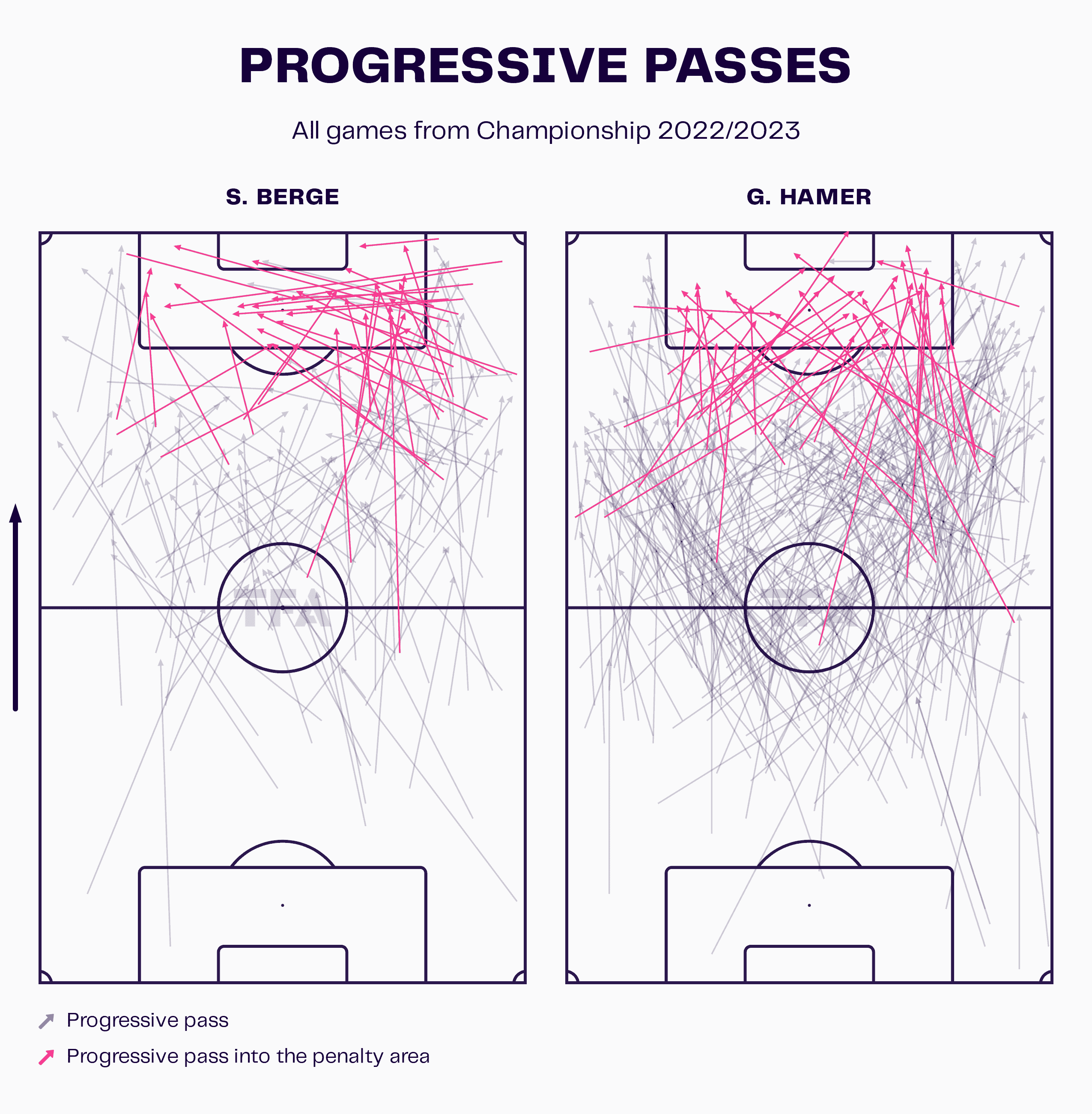
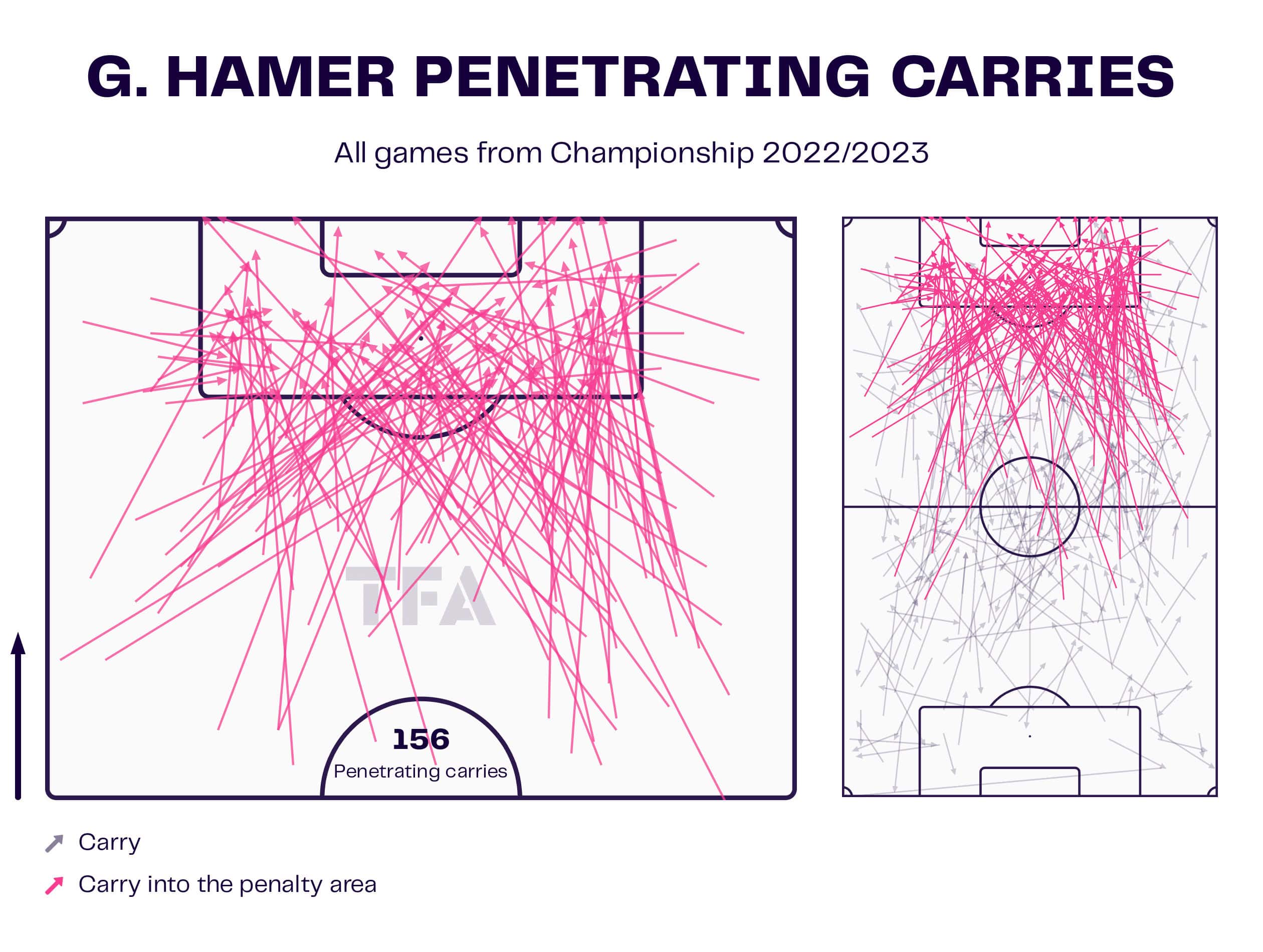
Previously, we highlighted Berge making 131 penetrating carries into the opposition area last season.
Hamer managed 156, which outperforms the former Sheffield United man quite significantly.
Additionally, Hamer was not too far off matching Berge regarding dribbling.
The Norwegian averaged 3.9 dribbles per 90 with a success rate of 63.95%, whereas Gustavo Hamer averaged 2.6 dribbles per 90 with a 59.83% success rate.
Defensively, we know that Berge averaged 3.03 interceptions per 90 by comparison.
Meanwhile, Hamer averaged 4.29.
Moreover, the former Coventry man averaged 9.02 recoveries per 90 with 43.3% in the opposition half, whilst Berge contributed 6.59 recoveries per 90 with 55.6% in the opponent’s half.
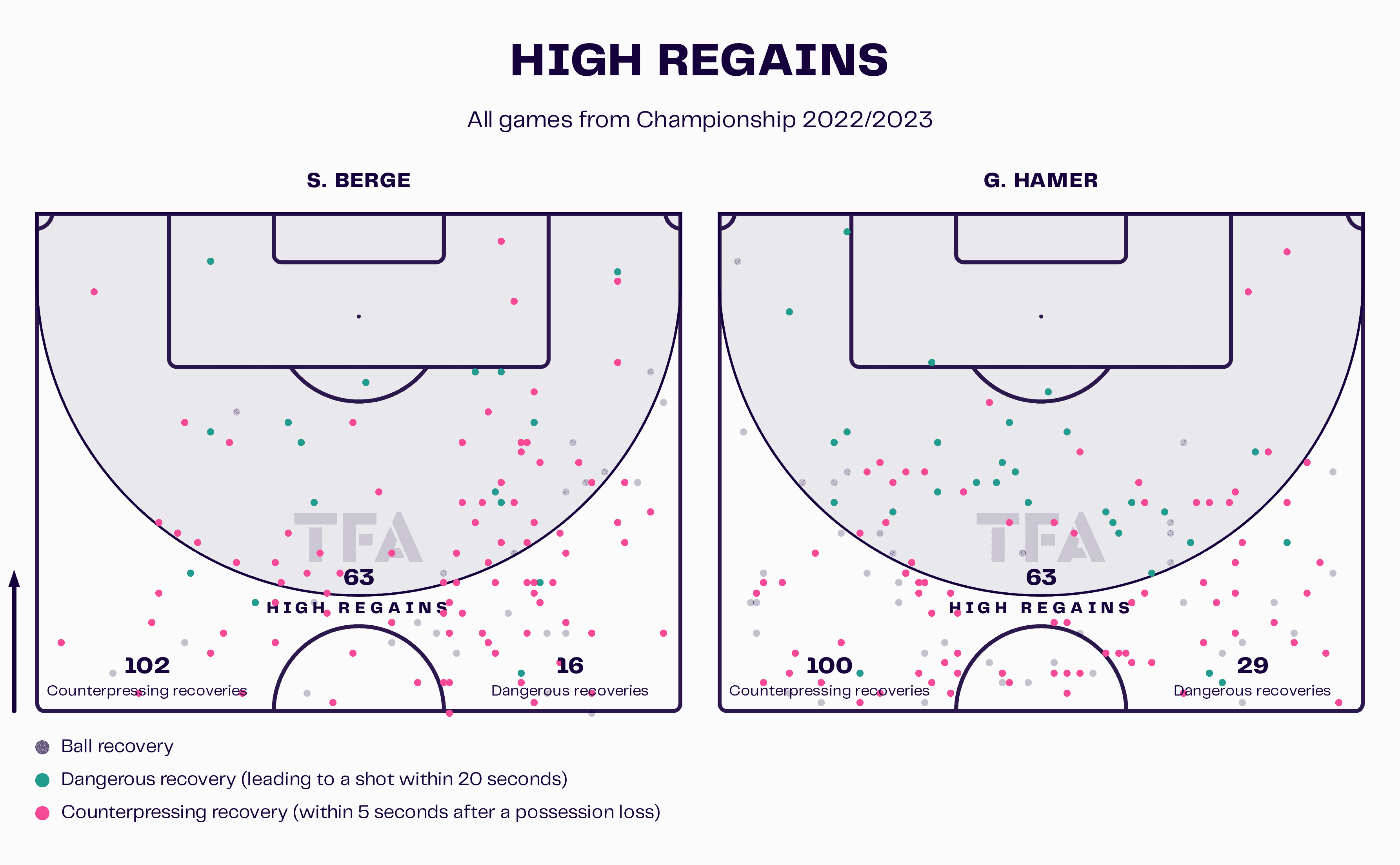
We can see from the data viz when it comes to counter-pressing, there are some similarities between the two.
Berge managed 102 counter-pressing recoveries, only two more than Hamer.
Both players completed 63 high regains; the only real difference is that Hamer completed 29 dangerous recoveries, which is a recovery that leads to a shot within 20 seconds.
It is easy to see why Sheffield United have identified Gustavo Hamer as the man to replace Sander Berge.
They are quite similar in many ways, with the man from Coventry City FC representing an exciting prospect who could provide some vital goals and assists for the Blades, who will most likely be fighting relegation.
With Souza acting as a defensive midfielder looking to break up play and prevent opposition attacks, Hamer’s attacking abilities could really flourish, and he could end up being a key player in Paul Heckingbottom’s team.
Conclusion
In this tactical analysis and scout report, we discussed why Vincent Kompany and Burnley moved to bring Sander Berge to Turf Moor.
We have seen how effective Sander Berge Style Of Play has been for Sheffield United over the last couple of seasons and what Burnley fans can expect from their new addition.
We have also looked at the man Sheffield United have brought in to replace Berge – Gustavo Hamer.
We have compared the two and seen why Paul Heckingbottom thinks he is the man to fill the Berge-shaped hole in the team.
Overall, Burnley are inheriting a good player for a very reasonable price, plus the Blades may be bringing in a player who is equally as good as the player they have lost.
These transfers could actually represent good deals for both clubs.





Comments